Electroconvulsive Therapy (ECT) - PDF
VerifiedAdded on 2021/06/15
|34
|6396
|53
AI Summary
Contribute Materials
Your contribution can guide someone’s learning journey. Share your
documents today.

Research proposal
Name of the student:
Name of the University:
Author’s note
1
Name of the student:
Name of the University:
Author’s note
1
Secure Best Marks with AI Grader
Need help grading? Try our AI Grader for instant feedback on your assignments.
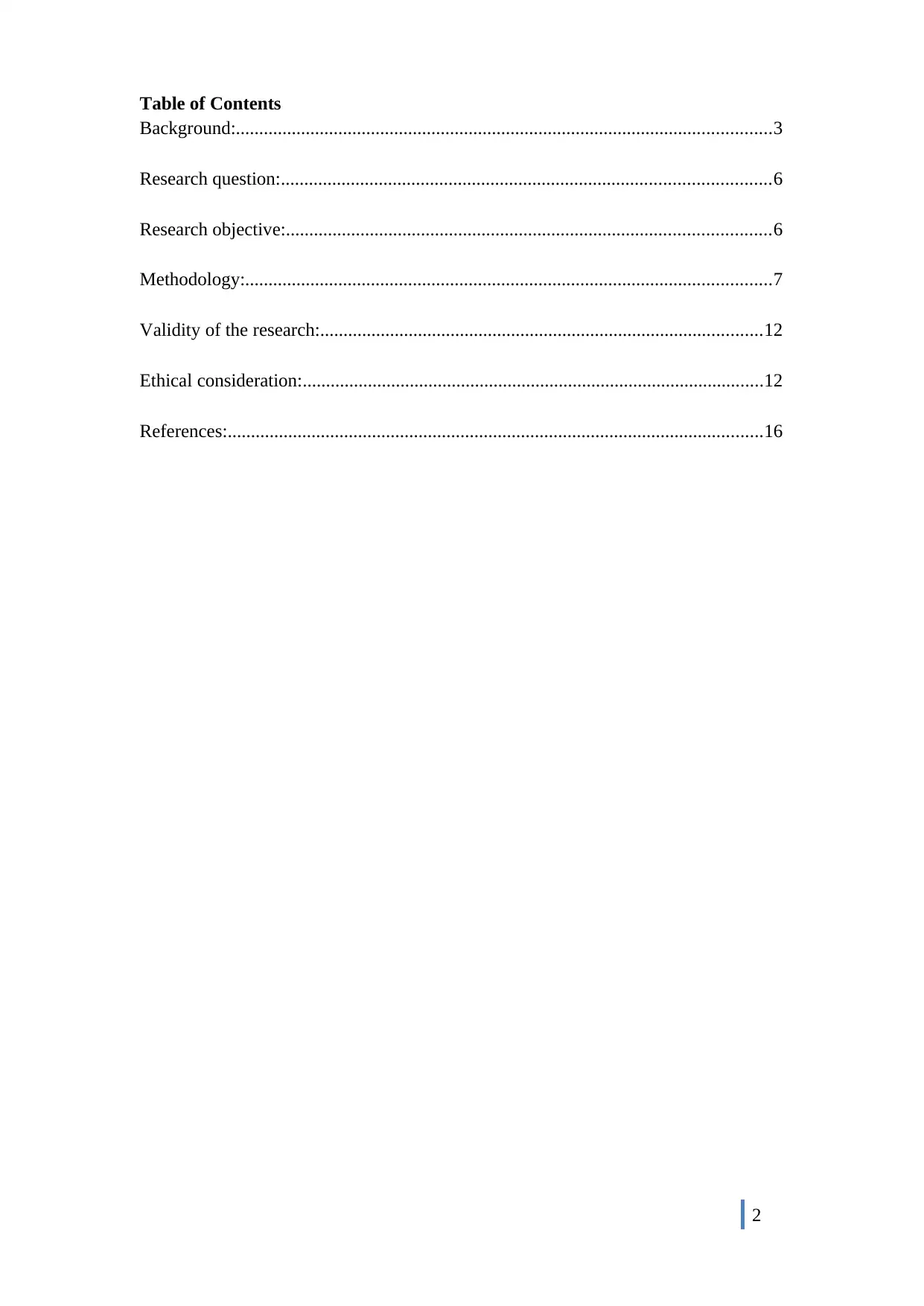
Table of Contents
Background:...................................................................................................................3
Research question:.........................................................................................................6
Research objective:........................................................................................................6
Methodology:.................................................................................................................7
Validity of the research:...............................................................................................12
Ethical consideration:...................................................................................................12
References:...................................................................................................................16
2
Background:...................................................................................................................3
Research question:.........................................................................................................6
Research objective:........................................................................................................6
Methodology:.................................................................................................................7
Validity of the research:...............................................................................................12
Ethical consideration:...................................................................................................12
References:...................................................................................................................16
2
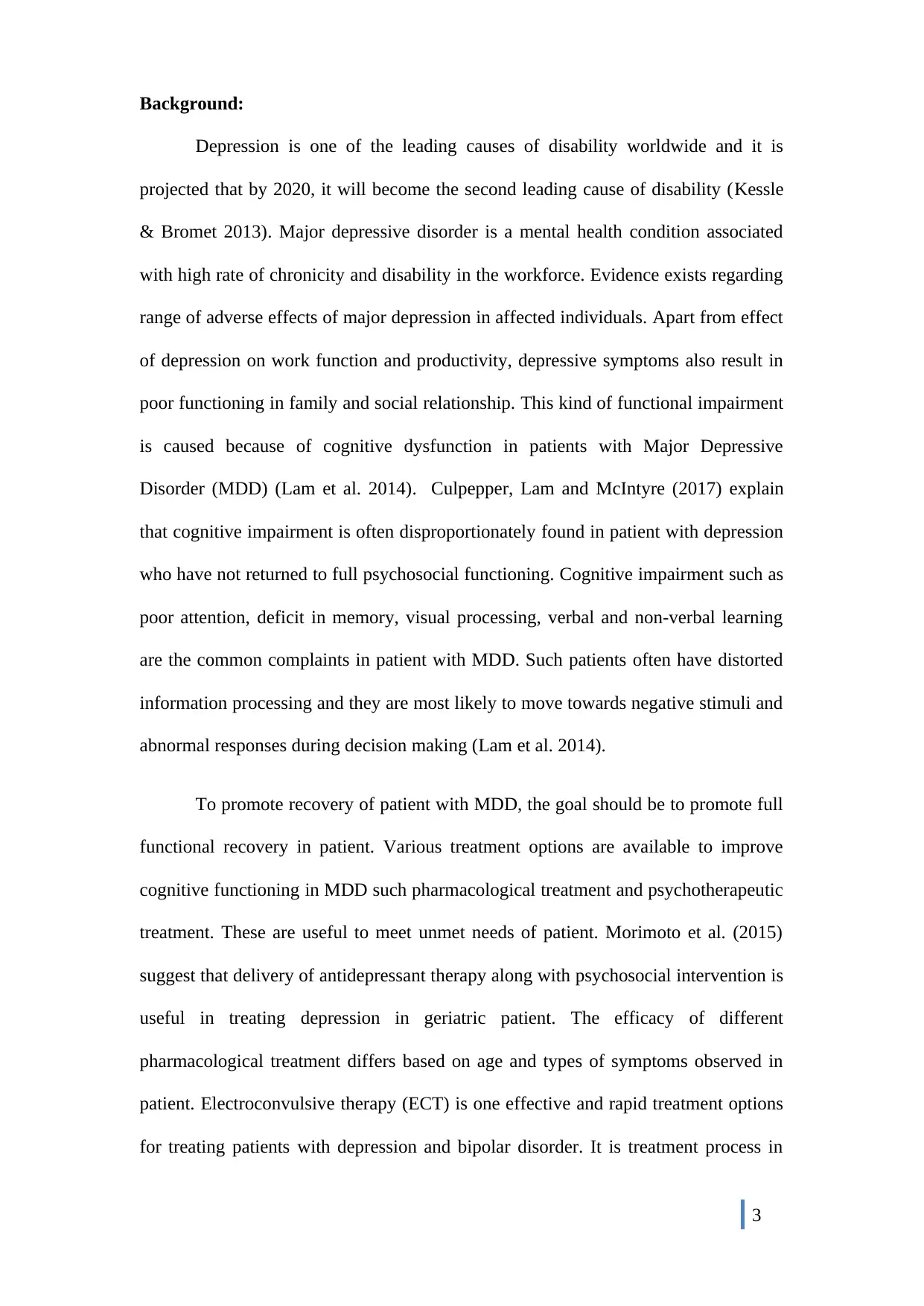
Background:
Depression is one of the leading causes of disability worldwide and it is
projected that by 2020, it will become the second leading cause of disability (Kessle
& Bromet 2013). Major depressive disorder is a mental health condition associated
with high rate of chronicity and disability in the workforce. Evidence exists regarding
range of adverse effects of major depression in affected individuals. Apart from effect
of depression on work function and productivity, depressive symptoms also result in
poor functioning in family and social relationship. This kind of functional impairment
is caused because of cognitive dysfunction in patients with Major Depressive
Disorder (MDD) (Lam et al. 2014). Culpepper, Lam and McIntyre (2017) explain
that cognitive impairment is often disproportionately found in patient with depression
who have not returned to full psychosocial functioning. Cognitive impairment such as
poor attention, deficit in memory, visual processing, verbal and non-verbal learning
are the common complaints in patient with MDD. Such patients often have distorted
information processing and they are most likely to move towards negative stimuli and
abnormal responses during decision making (Lam et al. 2014).
To promote recovery of patient with MDD, the goal should be to promote full
functional recovery in patient. Various treatment options are available to improve
cognitive functioning in MDD such pharmacological treatment and psychotherapeutic
treatment. These are useful to meet unmet needs of patient. Morimoto et al. (2015)
suggest that delivery of antidepressant therapy along with psychosocial intervention is
useful in treating depression in geriatric patient. The efficacy of different
pharmacological treatment differs based on age and types of symptoms observed in
patient. Electroconvulsive therapy (ECT) is one effective and rapid treatment options
for treating patients with depression and bipolar disorder. It is treatment process in
3
Depression is one of the leading causes of disability worldwide and it is
projected that by 2020, it will become the second leading cause of disability (Kessle
& Bromet 2013). Major depressive disorder is a mental health condition associated
with high rate of chronicity and disability in the workforce. Evidence exists regarding
range of adverse effects of major depression in affected individuals. Apart from effect
of depression on work function and productivity, depressive symptoms also result in
poor functioning in family and social relationship. This kind of functional impairment
is caused because of cognitive dysfunction in patients with Major Depressive
Disorder (MDD) (Lam et al. 2014). Culpepper, Lam and McIntyre (2017) explain
that cognitive impairment is often disproportionately found in patient with depression
who have not returned to full psychosocial functioning. Cognitive impairment such as
poor attention, deficit in memory, visual processing, verbal and non-verbal learning
are the common complaints in patient with MDD. Such patients often have distorted
information processing and they are most likely to move towards negative stimuli and
abnormal responses during decision making (Lam et al. 2014).
To promote recovery of patient with MDD, the goal should be to promote full
functional recovery in patient. Various treatment options are available to improve
cognitive functioning in MDD such pharmacological treatment and psychotherapeutic
treatment. These are useful to meet unmet needs of patient. Morimoto et al. (2015)
suggest that delivery of antidepressant therapy along with psychosocial intervention is
useful in treating depression in geriatric patient. The efficacy of different
pharmacological treatment differs based on age and types of symptoms observed in
patient. Electroconvulsive therapy (ECT) is one effective and rapid treatment options
for treating patients with depression and bipolar disorder. It is treatment process in
3
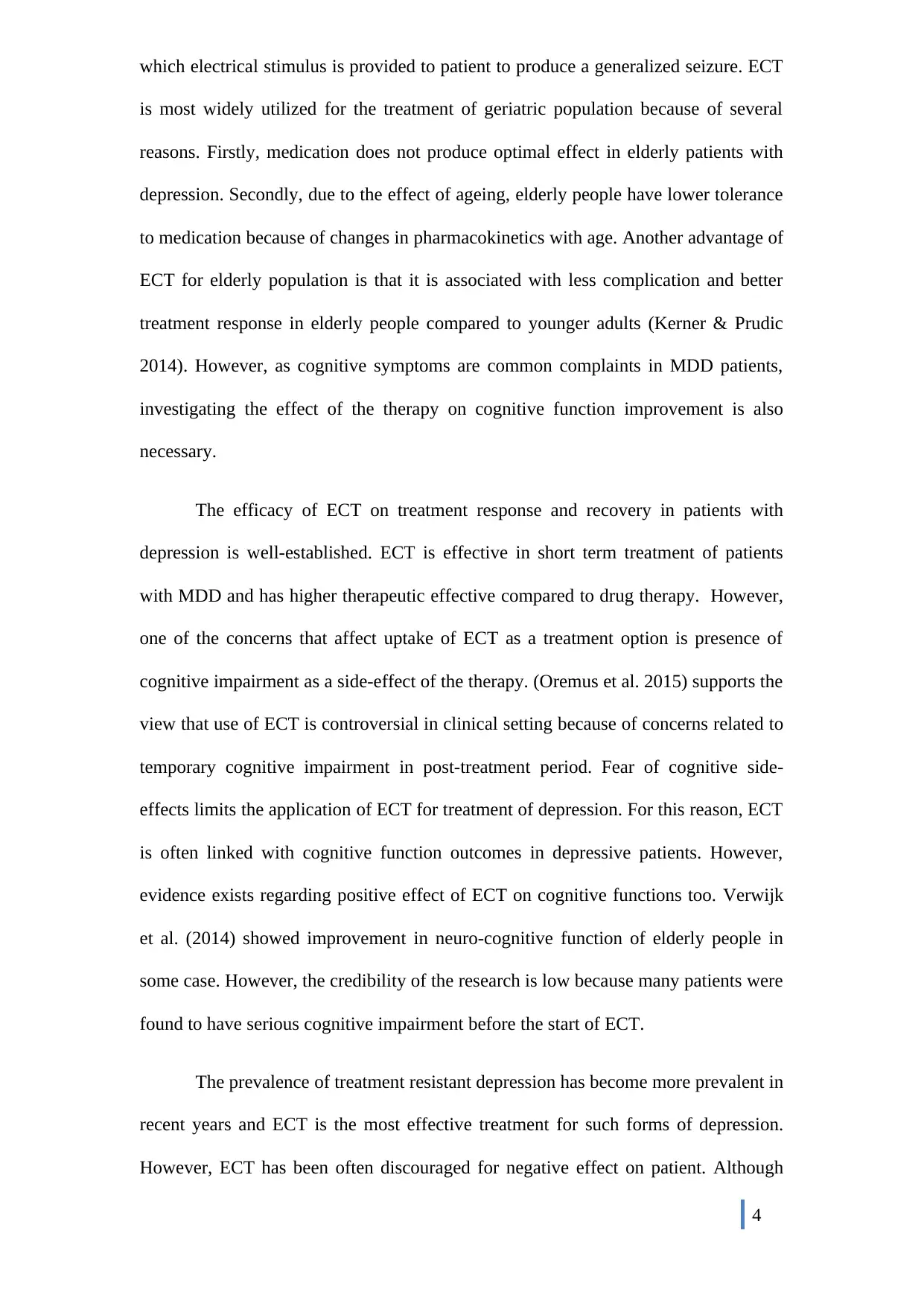
which electrical stimulus is provided to patient to produce a generalized seizure. ECT
is most widely utilized for the treatment of geriatric population because of several
reasons. Firstly, medication does not produce optimal effect in elderly patients with
depression. Secondly, due to the effect of ageing, elderly people have lower tolerance
to medication because of changes in pharmacokinetics with age. Another advantage of
ECT for elderly population is that it is associated with less complication and better
treatment response in elderly people compared to younger adults (Kerner & Prudic
2014). However, as cognitive symptoms are common complaints in MDD patients,
investigating the effect of the therapy on cognitive function improvement is also
necessary.
The efficacy of ECT on treatment response and recovery in patients with
depression is well-established. ECT is effective in short term treatment of patients
with MDD and has higher therapeutic effective compared to drug therapy. However,
one of the concerns that affect uptake of ECT as a treatment option is presence of
cognitive impairment as a side-effect of the therapy. (Oremus et al. 2015) supports the
view that use of ECT is controversial in clinical setting because of concerns related to
temporary cognitive impairment in post-treatment period. Fear of cognitive side-
effects limits the application of ECT for treatment of depression. For this reason, ECT
is often linked with cognitive function outcomes in depressive patients. However,
evidence exists regarding positive effect of ECT on cognitive functions too. Verwijk
et al. (2014) showed improvement in neuro-cognitive function of elderly people in
some case. However, the credibility of the research is low because many patients were
found to have serious cognitive impairment before the start of ECT.
The prevalence of treatment resistant depression has become more prevalent in
recent years and ECT is the most effective treatment for such forms of depression.
However, ECT has been often discouraged for negative effect on patient. Although
4
is most widely utilized for the treatment of geriatric population because of several
reasons. Firstly, medication does not produce optimal effect in elderly patients with
depression. Secondly, due to the effect of ageing, elderly people have lower tolerance
to medication because of changes in pharmacokinetics with age. Another advantage of
ECT for elderly population is that it is associated with less complication and better
treatment response in elderly people compared to younger adults (Kerner & Prudic
2014). However, as cognitive symptoms are common complaints in MDD patients,
investigating the effect of the therapy on cognitive function improvement is also
necessary.
The efficacy of ECT on treatment response and recovery in patients with
depression is well-established. ECT is effective in short term treatment of patients
with MDD and has higher therapeutic effective compared to drug therapy. However,
one of the concerns that affect uptake of ECT as a treatment option is presence of
cognitive impairment as a side-effect of the therapy. (Oremus et al. 2015) supports the
view that use of ECT is controversial in clinical setting because of concerns related to
temporary cognitive impairment in post-treatment period. Fear of cognitive side-
effects limits the application of ECT for treatment of depression. For this reason, ECT
is often linked with cognitive function outcomes in depressive patients. However,
evidence exists regarding positive effect of ECT on cognitive functions too. Verwijk
et al. (2014) showed improvement in neuro-cognitive function of elderly people in
some case. However, the credibility of the research is low because many patients were
found to have serious cognitive impairment before the start of ECT.
The prevalence of treatment resistant depression has become more prevalent in
recent years and ECT is the most effective treatment for such forms of depression.
However, ECT has been often discouraged for negative effect on patient. Although
4
Secure Best Marks with AI Grader
Need help grading? Try our AI Grader for instant feedback on your assignments.
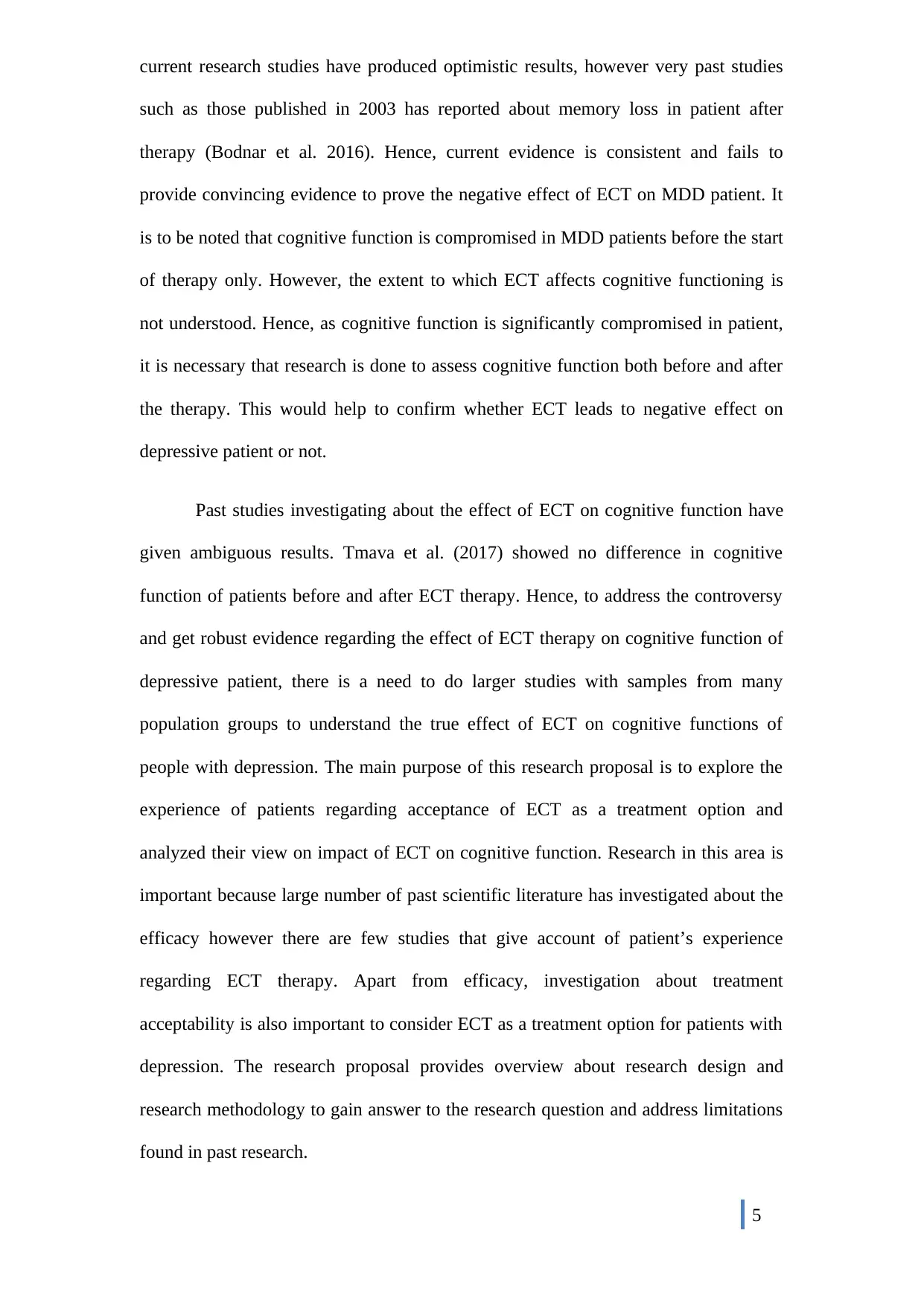
current research studies have produced optimistic results, however very past studies
such as those published in 2003 has reported about memory loss in patient after
therapy (Bodnar et al. 2016). Hence, current evidence is consistent and fails to
provide convincing evidence to prove the negative effect of ECT on MDD patient. It
is to be noted that cognitive function is compromised in MDD patients before the start
of therapy only. However, the extent to which ECT affects cognitive functioning is
not understood. Hence, as cognitive function is significantly compromised in patient,
it is necessary that research is done to assess cognitive function both before and after
the therapy. This would help to confirm whether ECT leads to negative effect on
depressive patient or not.
Past studies investigating about the effect of ECT on cognitive function have
given ambiguous results. Tmava et al. (2017) showed no difference in cognitive
function of patients before and after ECT therapy. Hence, to address the controversy
and get robust evidence regarding the effect of ECT therapy on cognitive function of
depressive patient, there is a need to do larger studies with samples from many
population groups to understand the true effect of ECT on cognitive functions of
people with depression. The main purpose of this research proposal is to explore the
experience of patients regarding acceptance of ECT as a treatment option and
analyzed their view on impact of ECT on cognitive function. Research in this area is
important because large number of past scientific literature has investigated about the
efficacy however there are few studies that give account of patient’s experience
regarding ECT therapy. Apart from efficacy, investigation about treatment
acceptability is also important to consider ECT as a treatment option for patients with
depression. The research proposal provides overview about research design and
research methodology to gain answer to the research question and address limitations
found in past research.
5
such as those published in 2003 has reported about memory loss in patient after
therapy (Bodnar et al. 2016). Hence, current evidence is consistent and fails to
provide convincing evidence to prove the negative effect of ECT on MDD patient. It
is to be noted that cognitive function is compromised in MDD patients before the start
of therapy only. However, the extent to which ECT affects cognitive functioning is
not understood. Hence, as cognitive function is significantly compromised in patient,
it is necessary that research is done to assess cognitive function both before and after
the therapy. This would help to confirm whether ECT leads to negative effect on
depressive patient or not.
Past studies investigating about the effect of ECT on cognitive function have
given ambiguous results. Tmava et al. (2017) showed no difference in cognitive
function of patients before and after ECT therapy. Hence, to address the controversy
and get robust evidence regarding the effect of ECT therapy on cognitive function of
depressive patient, there is a need to do larger studies with samples from many
population groups to understand the true effect of ECT on cognitive functions of
people with depression. The main purpose of this research proposal is to explore the
experience of patients regarding acceptance of ECT as a treatment option and
analyzed their view on impact of ECT on cognitive function. Research in this area is
important because large number of past scientific literature has investigated about the
efficacy however there are few studies that give account of patient’s experience
regarding ECT therapy. Apart from efficacy, investigation about treatment
acceptability is also important to consider ECT as a treatment option for patients with
depression. The research proposal provides overview about research design and
research methodology to gain answer to the research question and address limitations
found in past research.
5
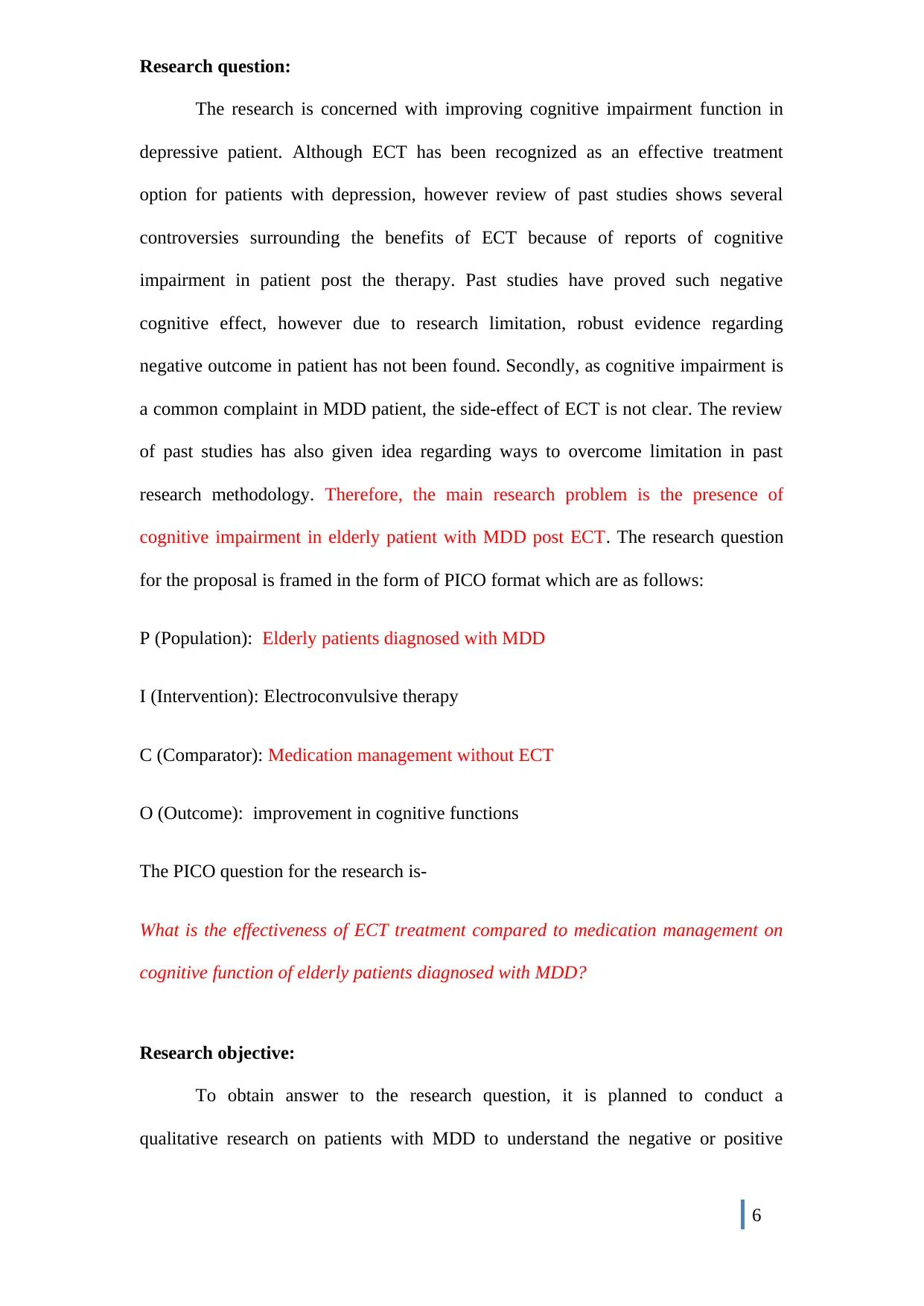
Research question:
The research is concerned with improving cognitive impairment function in
depressive patient. Although ECT has been recognized as an effective treatment
option for patients with depression, however review of past studies shows several
controversies surrounding the benefits of ECT because of reports of cognitive
impairment in patient post the therapy. Past studies have proved such negative
cognitive effect, however due to research limitation, robust evidence regarding
negative outcome in patient has not been found. Secondly, as cognitive impairment is
a common complaint in MDD patient, the side-effect of ECT is not clear. The review
of past studies has also given idea regarding ways to overcome limitation in past
research methodology. Therefore, the main research problem is the presence of
cognitive impairment in elderly patient with MDD post ECT. The research question
for the proposal is framed in the form of PICO format which are as follows:
P (Population): Elderly patients diagnosed with MDD
I (Intervention): Electroconvulsive therapy
C (Comparator): Medication management without ECT
O (Outcome): improvement in cognitive functions
The PICO question for the research is-
What is the effectiveness of ECT treatment compared to medication management on
cognitive function of elderly patients diagnosed with MDD?
Research objective:
To obtain answer to the research question, it is planned to conduct a
qualitative research on patients with MDD to understand the negative or positive
6
The research is concerned with improving cognitive impairment function in
depressive patient. Although ECT has been recognized as an effective treatment
option for patients with depression, however review of past studies shows several
controversies surrounding the benefits of ECT because of reports of cognitive
impairment in patient post the therapy. Past studies have proved such negative
cognitive effect, however due to research limitation, robust evidence regarding
negative outcome in patient has not been found. Secondly, as cognitive impairment is
a common complaint in MDD patient, the side-effect of ECT is not clear. The review
of past studies has also given idea regarding ways to overcome limitation in past
research methodology. Therefore, the main research problem is the presence of
cognitive impairment in elderly patient with MDD post ECT. The research question
for the proposal is framed in the form of PICO format which are as follows:
P (Population): Elderly patients diagnosed with MDD
I (Intervention): Electroconvulsive therapy
C (Comparator): Medication management without ECT
O (Outcome): improvement in cognitive functions
The PICO question for the research is-
What is the effectiveness of ECT treatment compared to medication management on
cognitive function of elderly patients diagnosed with MDD?
Research objective:
To obtain answer to the research question, it is planned to conduct a
qualitative research on patients with MDD to understand the negative or positive
6
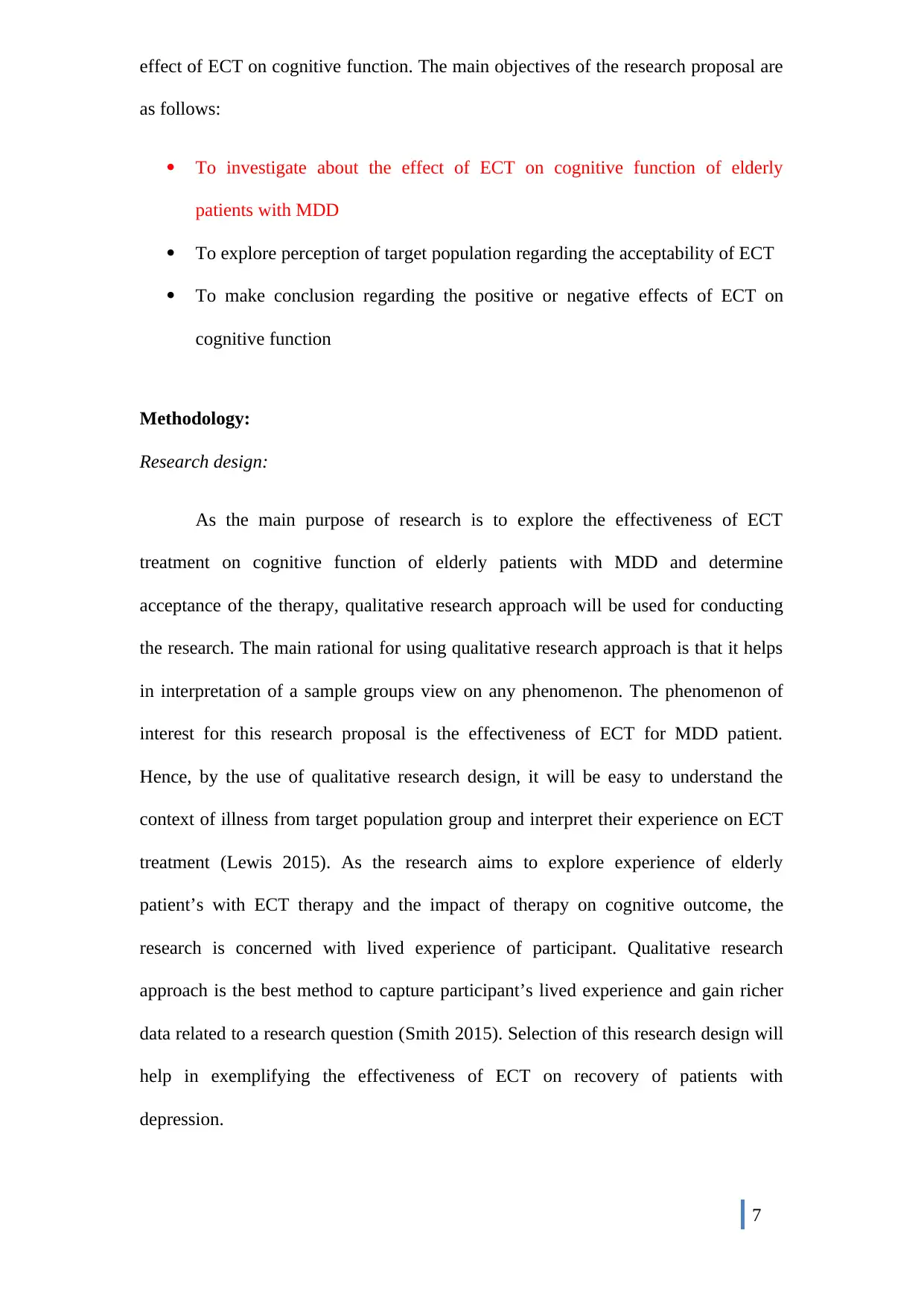
effect of ECT on cognitive function. The main objectives of the research proposal are
as follows:
To investigate about the effect of ECT on cognitive function of elderly
patients with MDD
To explore perception of target population regarding the acceptability of ECT
To make conclusion regarding the positive or negative effects of ECT on
cognitive function
Methodology:
Research design:
As the main purpose of research is to explore the effectiveness of ECT
treatment on cognitive function of elderly patients with MDD and determine
acceptance of the therapy, qualitative research approach will be used for conducting
the research. The main rational for using qualitative research approach is that it helps
in interpretation of a sample groups view on any phenomenon. The phenomenon of
interest for this research proposal is the effectiveness of ECT for MDD patient.
Hence, by the use of qualitative research design, it will be easy to understand the
context of illness from target population group and interpret their experience on ECT
treatment (Lewis 2015). As the research aims to explore experience of elderly
patient’s with ECT therapy and the impact of therapy on cognitive outcome, the
research is concerned with lived experience of participant. Qualitative research
approach is the best method to capture participant’s lived experience and gain richer
data related to a research question (Smith 2015). Selection of this research design will
help in exemplifying the effectiveness of ECT on recovery of patients with
depression.
7
as follows:
To investigate about the effect of ECT on cognitive function of elderly
patients with MDD
To explore perception of target population regarding the acceptability of ECT
To make conclusion regarding the positive or negative effects of ECT on
cognitive function
Methodology:
Research design:
As the main purpose of research is to explore the effectiveness of ECT
treatment on cognitive function of elderly patients with MDD and determine
acceptance of the therapy, qualitative research approach will be used for conducting
the research. The main rational for using qualitative research approach is that it helps
in interpretation of a sample groups view on any phenomenon. The phenomenon of
interest for this research proposal is the effectiveness of ECT for MDD patient.
Hence, by the use of qualitative research design, it will be easy to understand the
context of illness from target population group and interpret their experience on ECT
treatment (Lewis 2015). As the research aims to explore experience of elderly
patient’s with ECT therapy and the impact of therapy on cognitive outcome, the
research is concerned with lived experience of participant. Qualitative research
approach is the best method to capture participant’s lived experience and gain richer
data related to a research question (Smith 2015). Selection of this research design will
help in exemplifying the effectiveness of ECT on recovery of patients with
depression.
7
Paraphrase This Document
Need a fresh take? Get an instant paraphrase of this document with our AI Paraphraser
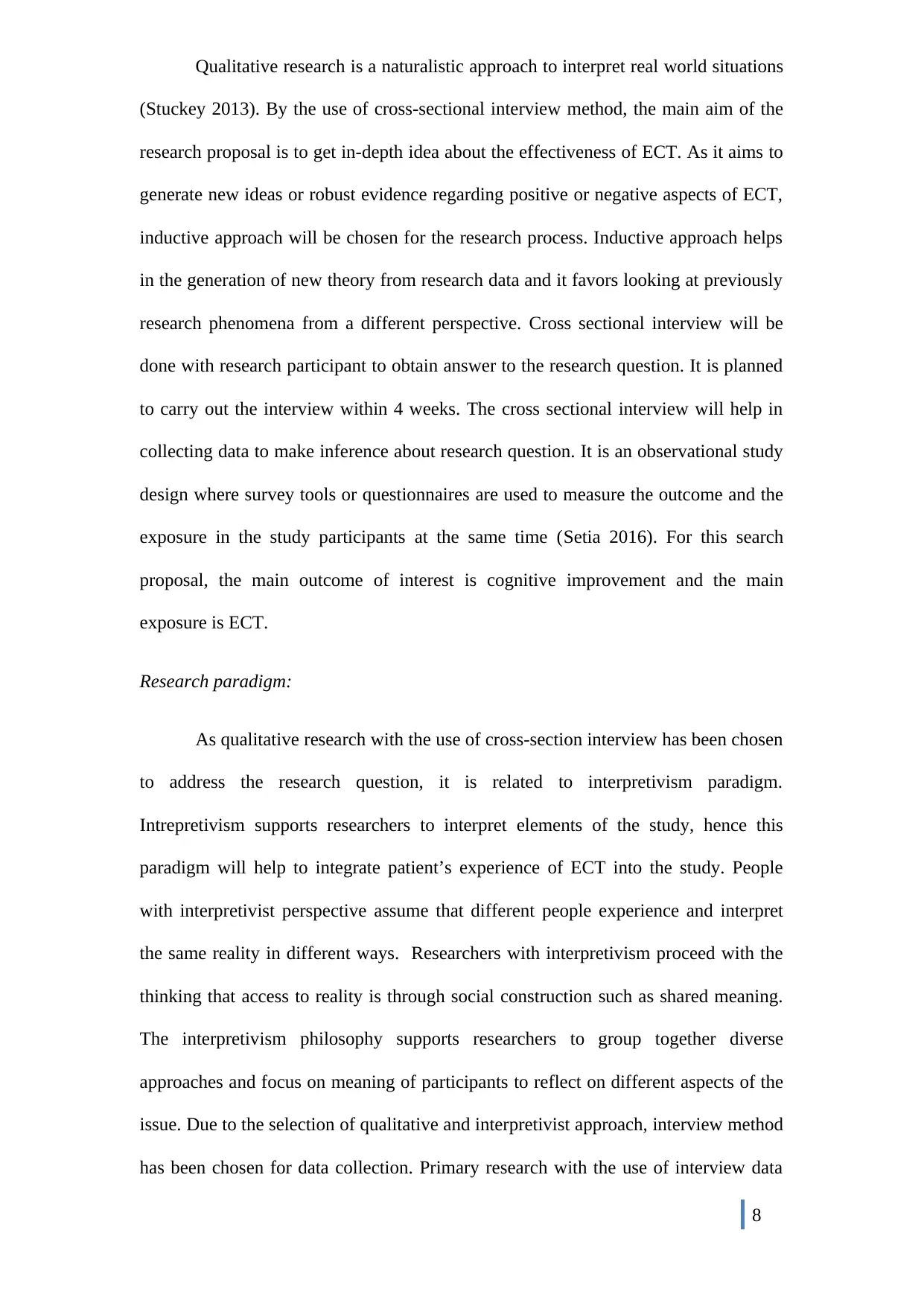
Qualitative research is a naturalistic approach to interpret real world situations
(Stuckey 2013). By the use of cross-sectional interview method, the main aim of the
research proposal is to get in-depth idea about the effectiveness of ECT. As it aims to
generate new ideas or robust evidence regarding positive or negative aspects of ECT,
inductive approach will be chosen for the research process. Inductive approach helps
in the generation of new theory from research data and it favors looking at previously
research phenomena from a different perspective. Cross sectional interview will be
done with research participant to obtain answer to the research question. It is planned
to carry out the interview within 4 weeks. The cross sectional interview will help in
collecting data to make inference about research question. It is an observational study
design where survey tools or questionnaires are used to measure the outcome and the
exposure in the study participants at the same time (Setia 2016). For this search
proposal, the main outcome of interest is cognitive improvement and the main
exposure is ECT.
Research paradigm:
As qualitative research with the use of cross-section interview has been chosen
to address the research question, it is related to interpretivism paradigm.
Intrepretivism supports researchers to interpret elements of the study, hence this
paradigm will help to integrate patient’s experience of ECT into the study. People
with interpretivist perspective assume that different people experience and interpret
the same reality in different ways. Researchers with interpretivism proceed with the
thinking that access to reality is through social construction such as shared meaning.
The interpretivism philosophy supports researchers to group together diverse
approaches and focus on meaning of participants to reflect on different aspects of the
issue. Due to the selection of qualitative and interpretivist approach, interview method
has been chosen for data collection. Primary research with the use of interview data
8
(Stuckey 2013). By the use of cross-sectional interview method, the main aim of the
research proposal is to get in-depth idea about the effectiveness of ECT. As it aims to
generate new ideas or robust evidence regarding positive or negative aspects of ECT,
inductive approach will be chosen for the research process. Inductive approach helps
in the generation of new theory from research data and it favors looking at previously
research phenomena from a different perspective. Cross sectional interview will be
done with research participant to obtain answer to the research question. It is planned
to carry out the interview within 4 weeks. The cross sectional interview will help in
collecting data to make inference about research question. It is an observational study
design where survey tools or questionnaires are used to measure the outcome and the
exposure in the study participants at the same time (Setia 2016). For this search
proposal, the main outcome of interest is cognitive improvement and the main
exposure is ECT.
Research paradigm:
As qualitative research with the use of cross-section interview has been chosen
to address the research question, it is related to interpretivism paradigm.
Intrepretivism supports researchers to interpret elements of the study, hence this
paradigm will help to integrate patient’s experience of ECT into the study. People
with interpretivist perspective assume that different people experience and interpret
the same reality in different ways. Researchers with interpretivism proceed with the
thinking that access to reality is through social construction such as shared meaning.
The interpretivism philosophy supports researchers to group together diverse
approaches and focus on meaning of participants to reflect on different aspects of the
issue. Due to the selection of qualitative and interpretivist approach, interview method
has been chosen for data collection. Primary research with the use of interview data
8
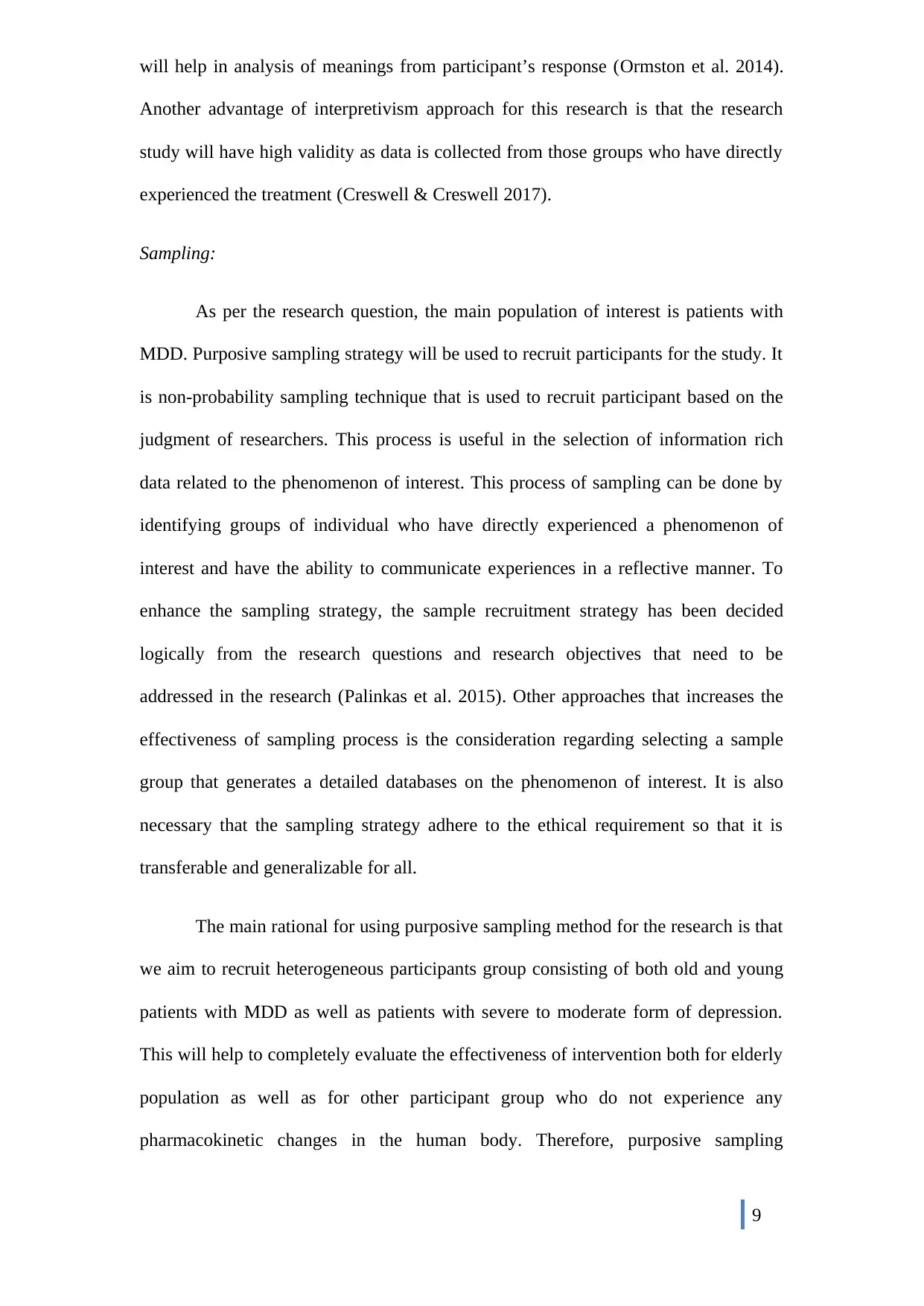
will help in analysis of meanings from participant’s response (Ormston et al. 2014).
Another advantage of interpretivism approach for this research is that the research
study will have high validity as data is collected from those groups who have directly
experienced the treatment (Creswell & Creswell 2017).
Sampling:
As per the research question, the main population of interest is patients with
MDD. Purposive sampling strategy will be used to recruit participants for the study. It
is non-probability sampling technique that is used to recruit participant based on the
judgment of researchers. This process is useful in the selection of information rich
data related to the phenomenon of interest. This process of sampling can be done by
identifying groups of individual who have directly experienced a phenomenon of
interest and have the ability to communicate experiences in a reflective manner. To
enhance the sampling strategy, the sample recruitment strategy has been decided
logically from the research questions and research objectives that need to be
addressed in the research (Palinkas et al. 2015). Other approaches that increases the
effectiveness of sampling process is the consideration regarding selecting a sample
group that generates a detailed databases on the phenomenon of interest. It is also
necessary that the sampling strategy adhere to the ethical requirement so that it is
transferable and generalizable for all.
The main rational for using purposive sampling method for the research is that
we aim to recruit heterogeneous participants group consisting of both old and young
patients with MDD as well as patients with severe to moderate form of depression.
This will help to completely evaluate the effectiveness of intervention both for elderly
population as well as for other participant group who do not experience any
pharmacokinetic changes in the human body. Therefore, purposive sampling
9
Another advantage of interpretivism approach for this research is that the research
study will have high validity as data is collected from those groups who have directly
experienced the treatment (Creswell & Creswell 2017).
Sampling:
As per the research question, the main population of interest is patients with
MDD. Purposive sampling strategy will be used to recruit participants for the study. It
is non-probability sampling technique that is used to recruit participant based on the
judgment of researchers. This process is useful in the selection of information rich
data related to the phenomenon of interest. This process of sampling can be done by
identifying groups of individual who have directly experienced a phenomenon of
interest and have the ability to communicate experiences in a reflective manner. To
enhance the sampling strategy, the sample recruitment strategy has been decided
logically from the research questions and research objectives that need to be
addressed in the research (Palinkas et al. 2015). Other approaches that increases the
effectiveness of sampling process is the consideration regarding selecting a sample
group that generates a detailed databases on the phenomenon of interest. It is also
necessary that the sampling strategy adhere to the ethical requirement so that it is
transferable and generalizable for all.
The main rational for using purposive sampling method for the research is that
we aim to recruit heterogeneous participants group consisting of both old and young
patients with MDD as well as patients with severe to moderate form of depression.
This will help to completely evaluate the effectiveness of intervention both for elderly
population as well as for other participant group who do not experience any
pharmacokinetic changes in the human body. Therefore, purposive sampling
9
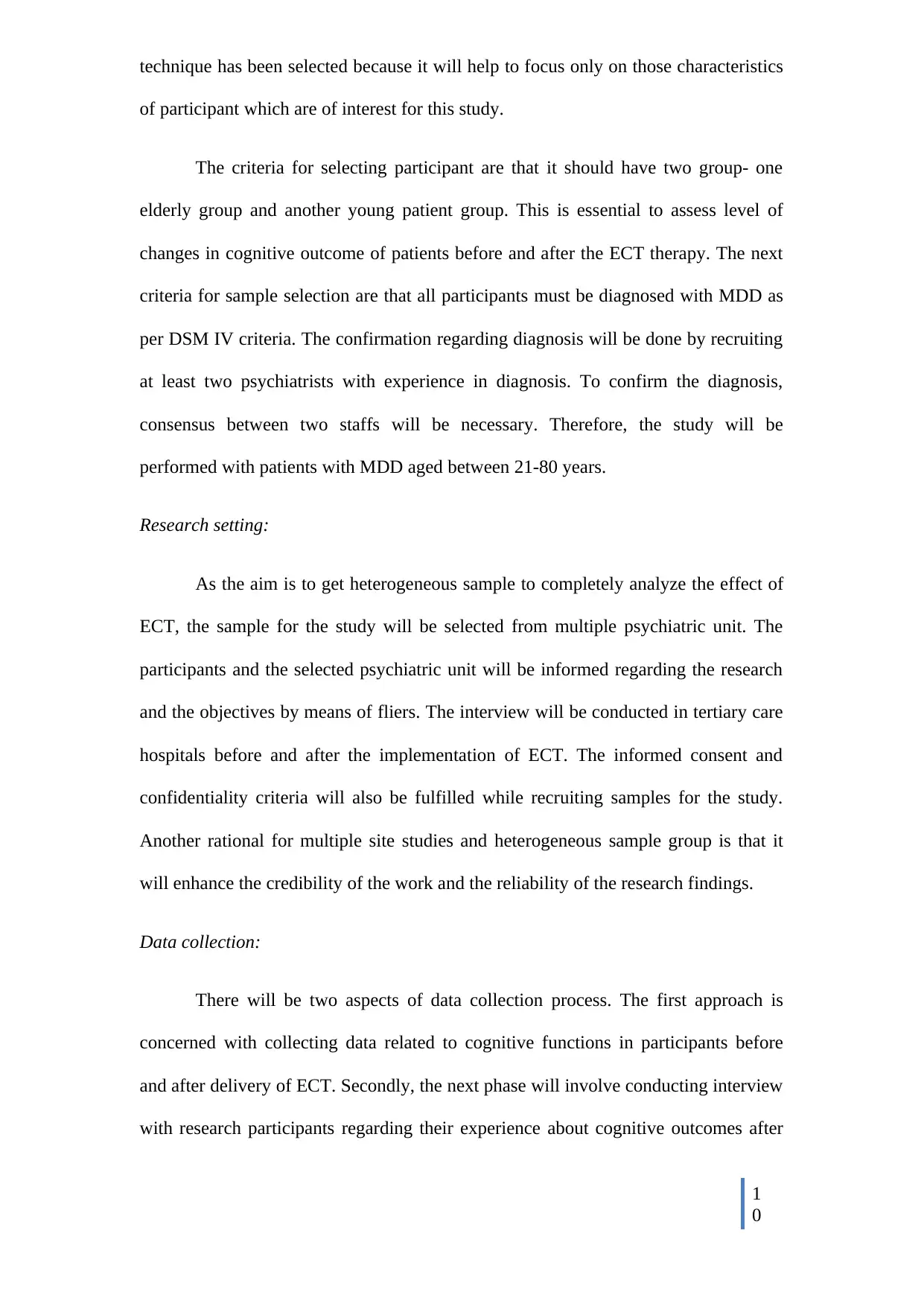
technique has been selected because it will help to focus only on those characteristics
of participant which are of interest for this study.
The criteria for selecting participant are that it should have two group- one
elderly group and another young patient group. This is essential to assess level of
changes in cognitive outcome of patients before and after the ECT therapy. The next
criteria for sample selection are that all participants must be diagnosed with MDD as
per DSM IV criteria. The confirmation regarding diagnosis will be done by recruiting
at least two psychiatrists with experience in diagnosis. To confirm the diagnosis,
consensus between two staffs will be necessary. Therefore, the study will be
performed with patients with MDD aged between 21-80 years.
Research setting:
As the aim is to get heterogeneous sample to completely analyze the effect of
ECT, the sample for the study will be selected from multiple psychiatric unit. The
participants and the selected psychiatric unit will be informed regarding the research
and the objectives by means of fliers. The interview will be conducted in tertiary care
hospitals before and after the implementation of ECT. The informed consent and
confidentiality criteria will also be fulfilled while recruiting samples for the study.
Another rational for multiple site studies and heterogeneous sample group is that it
will enhance the credibility of the work and the reliability of the research findings.
Data collection:
There will be two aspects of data collection process. The first approach is
concerned with collecting data related to cognitive functions in participants before
and after delivery of ECT. Secondly, the next phase will involve conducting interview
with research participants regarding their experience about cognitive outcomes after
1
0
of participant which are of interest for this study.
The criteria for selecting participant are that it should have two group- one
elderly group and another young patient group. This is essential to assess level of
changes in cognitive outcome of patients before and after the ECT therapy. The next
criteria for sample selection are that all participants must be diagnosed with MDD as
per DSM IV criteria. The confirmation regarding diagnosis will be done by recruiting
at least two psychiatrists with experience in diagnosis. To confirm the diagnosis,
consensus between two staffs will be necessary. Therefore, the study will be
performed with patients with MDD aged between 21-80 years.
Research setting:
As the aim is to get heterogeneous sample to completely analyze the effect of
ECT, the sample for the study will be selected from multiple psychiatric unit. The
participants and the selected psychiatric unit will be informed regarding the research
and the objectives by means of fliers. The interview will be conducted in tertiary care
hospitals before and after the implementation of ECT. The informed consent and
confidentiality criteria will also be fulfilled while recruiting samples for the study.
Another rational for multiple site studies and heterogeneous sample group is that it
will enhance the credibility of the work and the reliability of the research findings.
Data collection:
There will be two aspects of data collection process. The first approach is
concerned with collecting data related to cognitive functions in participants before
and after delivery of ECT. Secondly, the next phase will involve conducting interview
with research participants regarding their experience about cognitive outcomes after
1
0
Secure Best Marks with AI Grader
Need help grading? Try our AI Grader for instant feedback on your assignments.
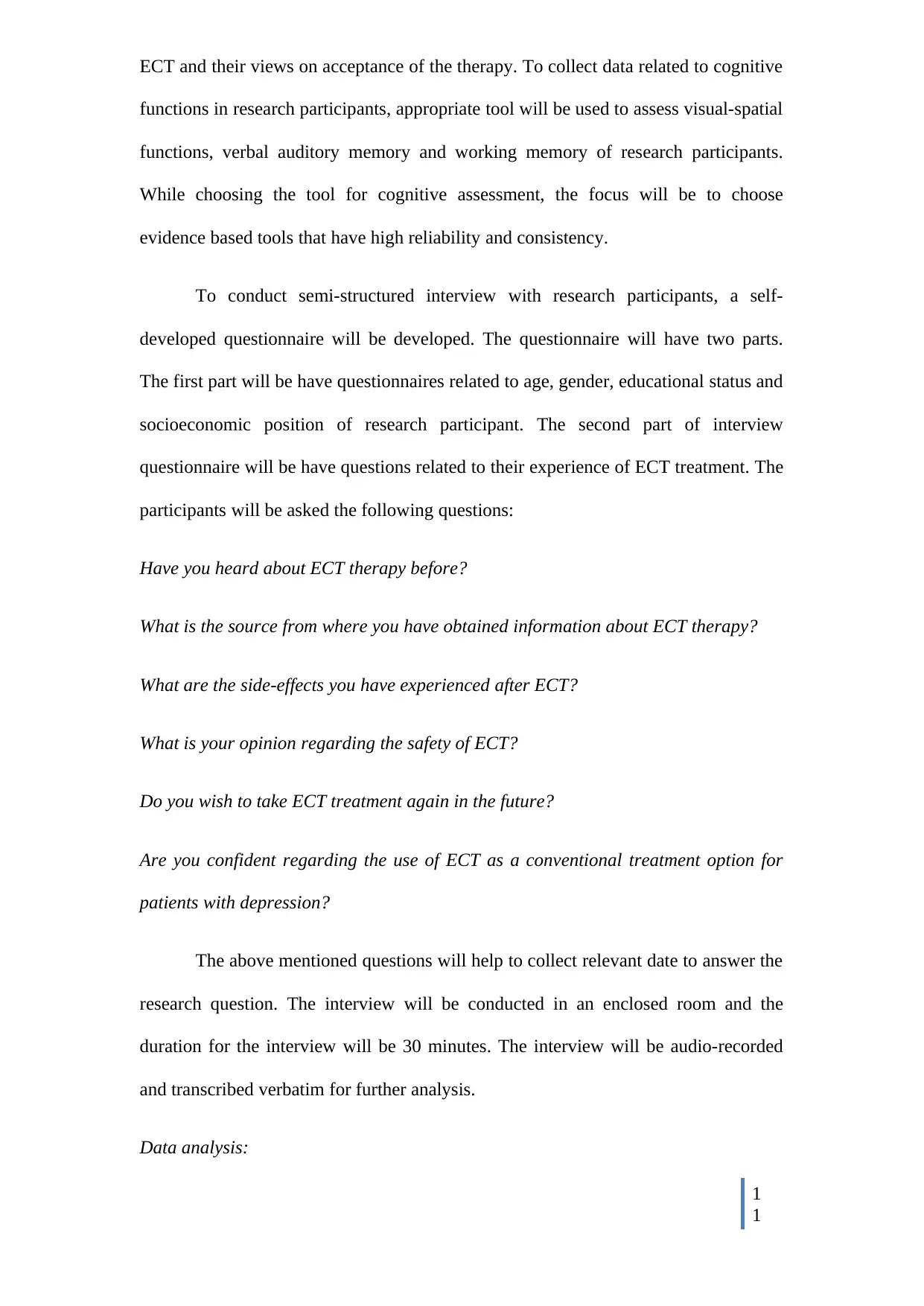
ECT and their views on acceptance of the therapy. To collect data related to cognitive
functions in research participants, appropriate tool will be used to assess visual-spatial
functions, verbal auditory memory and working memory of research participants.
While choosing the tool for cognitive assessment, the focus will be to choose
evidence based tools that have high reliability and consistency.
To conduct semi-structured interview with research participants, a self-
developed questionnaire will be developed. The questionnaire will have two parts.
The first part will be have questionnaires related to age, gender, educational status and
socioeconomic position of research participant. The second part of interview
questionnaire will be have questions related to their experience of ECT treatment. The
participants will be asked the following questions:
Have you heard about ECT therapy before?
What is the source from where you have obtained information about ECT therapy?
What are the side-effects you have experienced after ECT?
What is your opinion regarding the safety of ECT?
Do you wish to take ECT treatment again in the future?
Are you confident regarding the use of ECT as a conventional treatment option for
patients with depression?
The above mentioned questions will help to collect relevant date to answer the
research question. The interview will be conducted in an enclosed room and the
duration for the interview will be 30 minutes. The interview will be audio-recorded
and transcribed verbatim for further analysis.
Data analysis:
1
1
functions in research participants, appropriate tool will be used to assess visual-spatial
functions, verbal auditory memory and working memory of research participants.
While choosing the tool for cognitive assessment, the focus will be to choose
evidence based tools that have high reliability and consistency.
To conduct semi-structured interview with research participants, a self-
developed questionnaire will be developed. The questionnaire will have two parts.
The first part will be have questionnaires related to age, gender, educational status and
socioeconomic position of research participant. The second part of interview
questionnaire will be have questions related to their experience of ECT treatment. The
participants will be asked the following questions:
Have you heard about ECT therapy before?
What is the source from where you have obtained information about ECT therapy?
What are the side-effects you have experienced after ECT?
What is your opinion regarding the safety of ECT?
Do you wish to take ECT treatment again in the future?
Are you confident regarding the use of ECT as a conventional treatment option for
patients with depression?
The above mentioned questions will help to collect relevant date to answer the
research question. The interview will be conducted in an enclosed room and the
duration for the interview will be 30 minutes. The interview will be audio-recorded
and transcribed verbatim for further analysis.
Data analysis:
1
1
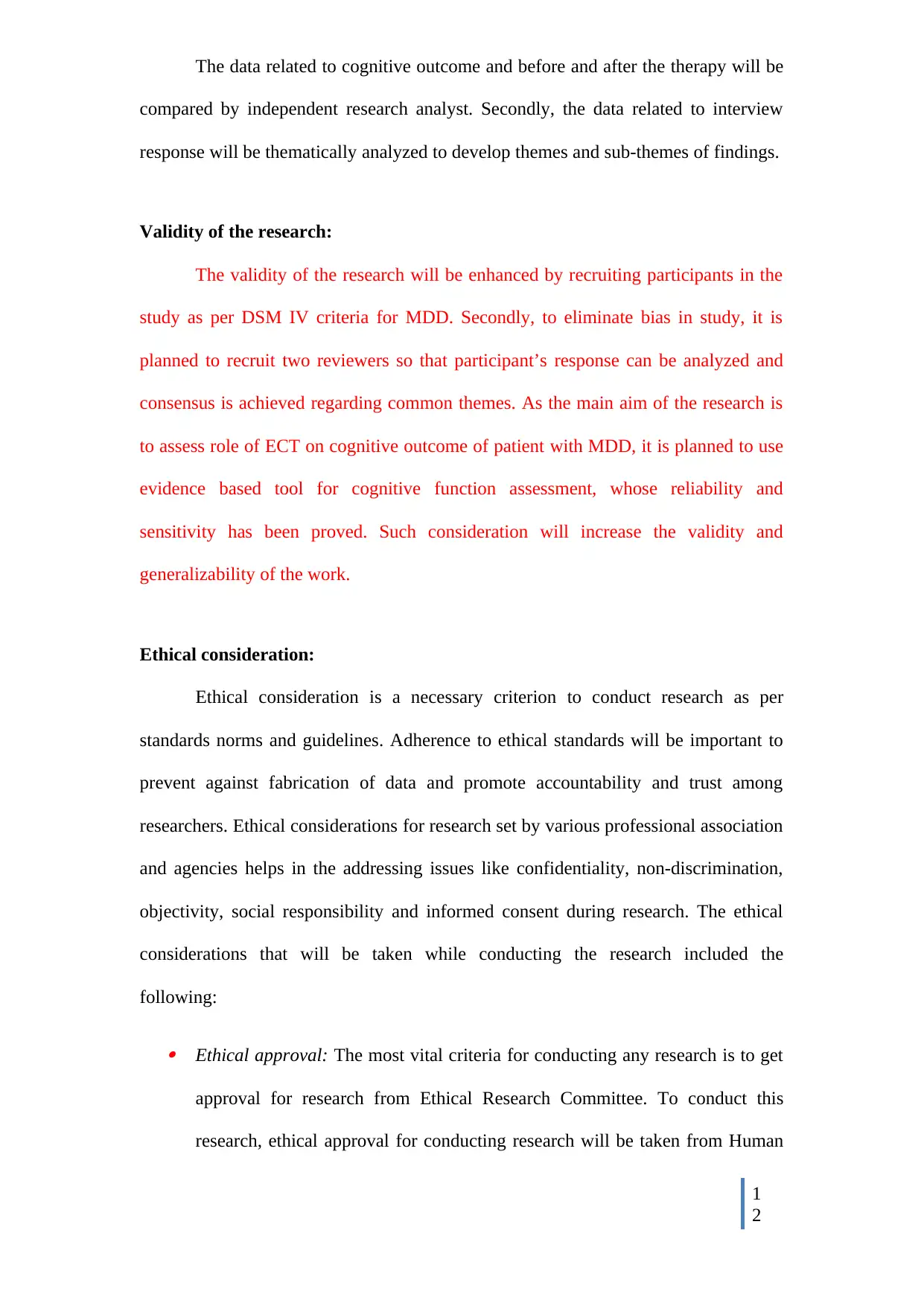
The data related to cognitive outcome and before and after the therapy will be
compared by independent research analyst. Secondly, the data related to interview
response will be thematically analyzed to develop themes and sub-themes of findings.
Validity of the research:
The validity of the research will be enhanced by recruiting participants in the
study as per DSM IV criteria for MDD. Secondly, to eliminate bias in study, it is
planned to recruit two reviewers so that participant’s response can be analyzed and
consensus is achieved regarding common themes. As the main aim of the research is
to assess role of ECT on cognitive outcome of patient with MDD, it is planned to use
evidence based tool for cognitive function assessment, whose reliability and
sensitivity has been proved. Such consideration will increase the validity and
generalizability of the work.
Ethical consideration:
Ethical consideration is a necessary criterion to conduct research as per
standards norms and guidelines. Adherence to ethical standards will be important to
prevent against fabrication of data and promote accountability and trust among
researchers. Ethical considerations for research set by various professional association
and agencies helps in the addressing issues like confidentiality, non-discrimination,
objectivity, social responsibility and informed consent during research. The ethical
considerations that will be taken while conducting the research included the
following:
Ethical approval: The most vital criteria for conducting any research is to get
approval for research from Ethical Research Committee. To conduct this
research, ethical approval for conducting research will be taken from Human
1
2
compared by independent research analyst. Secondly, the data related to interview
response will be thematically analyzed to develop themes and sub-themes of findings.
Validity of the research:
The validity of the research will be enhanced by recruiting participants in the
study as per DSM IV criteria for MDD. Secondly, to eliminate bias in study, it is
planned to recruit two reviewers so that participant’s response can be analyzed and
consensus is achieved regarding common themes. As the main aim of the research is
to assess role of ECT on cognitive outcome of patient with MDD, it is planned to use
evidence based tool for cognitive function assessment, whose reliability and
sensitivity has been proved. Such consideration will increase the validity and
generalizability of the work.
Ethical consideration:
Ethical consideration is a necessary criterion to conduct research as per
standards norms and guidelines. Adherence to ethical standards will be important to
prevent against fabrication of data and promote accountability and trust among
researchers. Ethical considerations for research set by various professional association
and agencies helps in the addressing issues like confidentiality, non-discrimination,
objectivity, social responsibility and informed consent during research. The ethical
considerations that will be taken while conducting the research included the
following:
Ethical approval: The most vital criteria for conducting any research is to get
approval for research from Ethical Research Committee. To conduct this
research, ethical approval for conducting research will be taken from Human
1
2
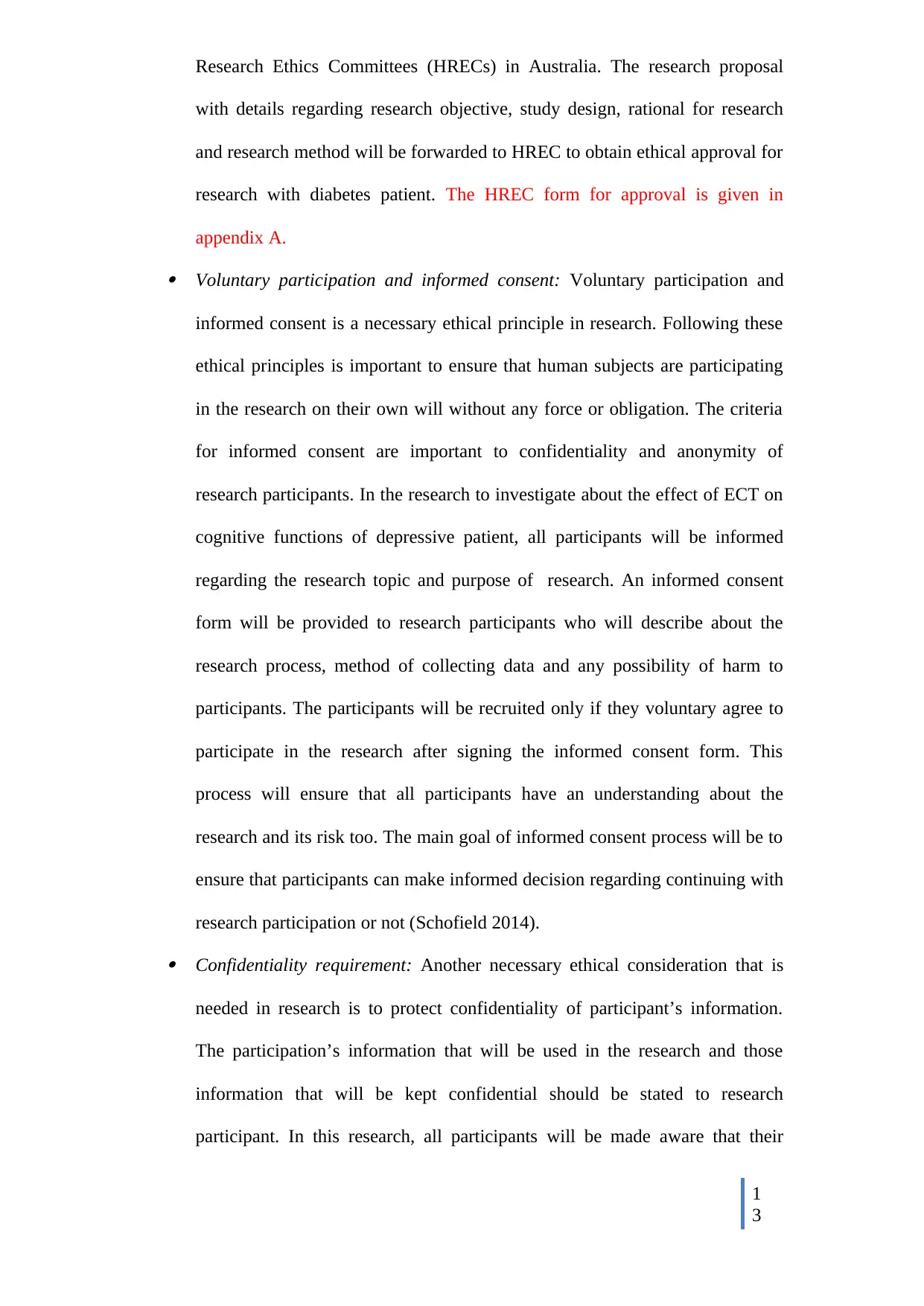
Research Ethics Committees (HRECs) in Australia. The research proposal
with details regarding research objective, study design, rational for research
and research method will be forwarded to HREC to obtain ethical approval for
research with diabetes patient. The HREC form for approval is given in
appendix A. Voluntary participation and informed consent: Voluntary participation and
informed consent is a necessary ethical principle in research. Following these
ethical principles is important to ensure that human subjects are participating
in the research on their own will without any force or obligation. The criteria
for informed consent are important to confidentiality and anonymity of
research participants. In the research to investigate about the effect of ECT on
cognitive functions of depressive patient, all participants will be informed
regarding the research topic and purpose of research. An informed consent
form will be provided to research participants who will describe about the
research process, method of collecting data and any possibility of harm to
participants. The participants will be recruited only if they voluntary agree to
participate in the research after signing the informed consent form. This
process will ensure that all participants have an understanding about the
research and its risk too. The main goal of informed consent process will be to
ensure that participants can make informed decision regarding continuing with
research participation or not (Schofield 2014). Confidentiality requirement: Another necessary ethical consideration that is
needed in research is to protect confidentiality of participant’s information.
The participation’s information that will be used in the research and those
information that will be kept confidential should be stated to research
participant. In this research, all participants will be made aware that their
1
3
with details regarding research objective, study design, rational for research
and research method will be forwarded to HREC to obtain ethical approval for
research with diabetes patient. The HREC form for approval is given in
appendix A. Voluntary participation and informed consent: Voluntary participation and
informed consent is a necessary ethical principle in research. Following these
ethical principles is important to ensure that human subjects are participating
in the research on their own will without any force or obligation. The criteria
for informed consent are important to confidentiality and anonymity of
research participants. In the research to investigate about the effect of ECT on
cognitive functions of depressive patient, all participants will be informed
regarding the research topic and purpose of research. An informed consent
form will be provided to research participants who will describe about the
research process, method of collecting data and any possibility of harm to
participants. The participants will be recruited only if they voluntary agree to
participate in the research after signing the informed consent form. This
process will ensure that all participants have an understanding about the
research and its risk too. The main goal of informed consent process will be to
ensure that participants can make informed decision regarding continuing with
research participation or not (Schofield 2014). Confidentiality requirement: Another necessary ethical consideration that is
needed in research is to protect confidentiality of participant’s information.
The participation’s information that will be used in the research and those
information that will be kept confidential should be stated to research
participant. In this research, all participants will be made aware that their
1
3
Paraphrase This Document
Need a fresh take? Get an instant paraphrase of this document with our AI Paraphraser
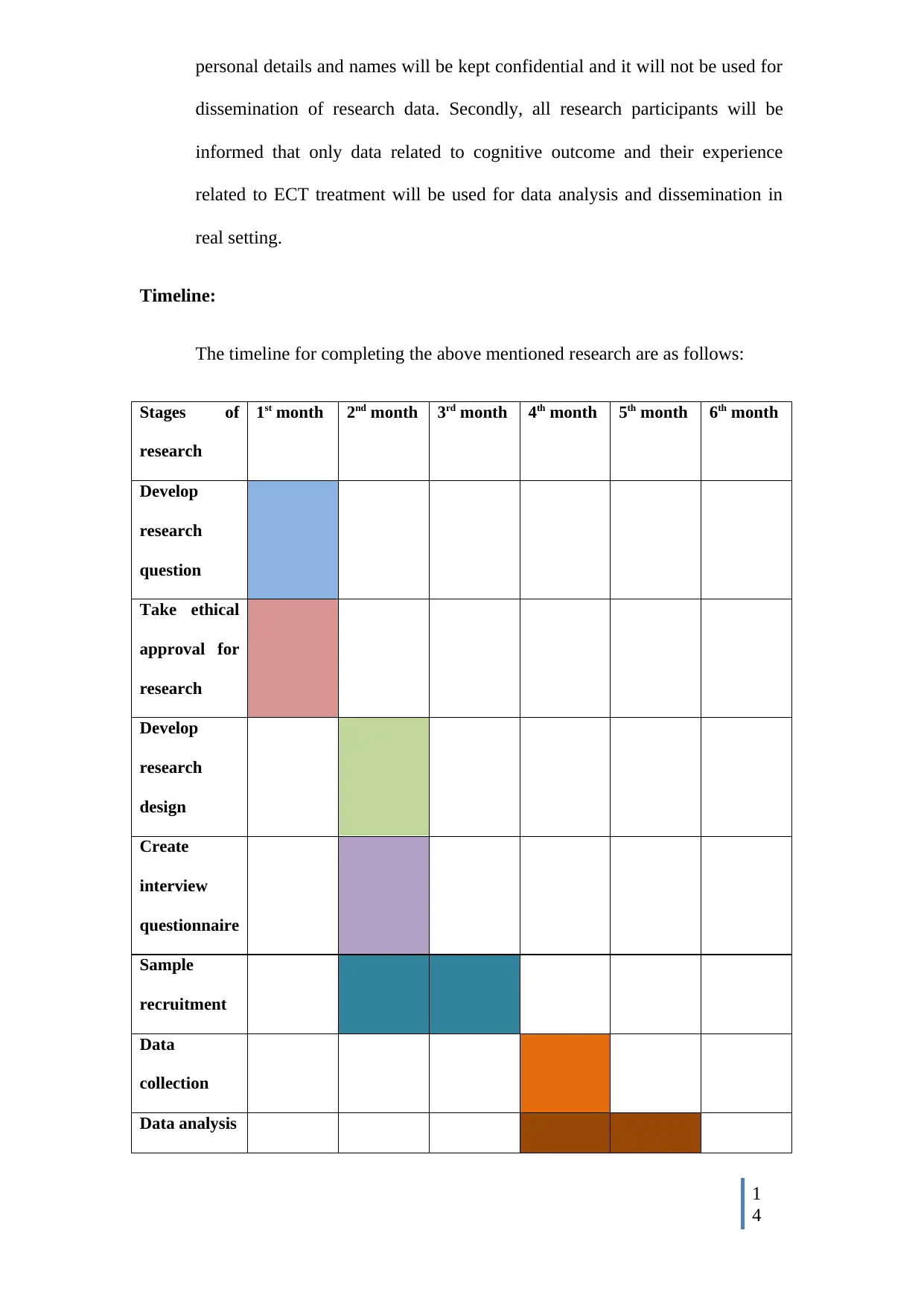
personal details and names will be kept confidential and it will not be used for
dissemination of research data. Secondly, all research participants will be
informed that only data related to cognitive outcome and their experience
related to ECT treatment will be used for data analysis and dissemination in
real setting.
Timeline:
The timeline for completing the above mentioned research are as follows:
Stages of
research
1st month 2nd month 3rd month 4th month 5th month 6th month
Develop
research
question
Take ethical
approval for
research
Develop
research
design
Create
interview
questionnaire
Sample
recruitment
Data
collection
Data analysis
1
4
dissemination of research data. Secondly, all research participants will be
informed that only data related to cognitive outcome and their experience
related to ECT treatment will be used for data analysis and dissemination in
real setting.
Timeline:
The timeline for completing the above mentioned research are as follows:
Stages of
research
1st month 2nd month 3rd month 4th month 5th month 6th month
Develop
research
question
Take ethical
approval for
research
Develop
research
design
Create
interview
questionnaire
Sample
recruitment
Data
collection
Data analysis
1
4

Research
findings
1
5
findings
1
5
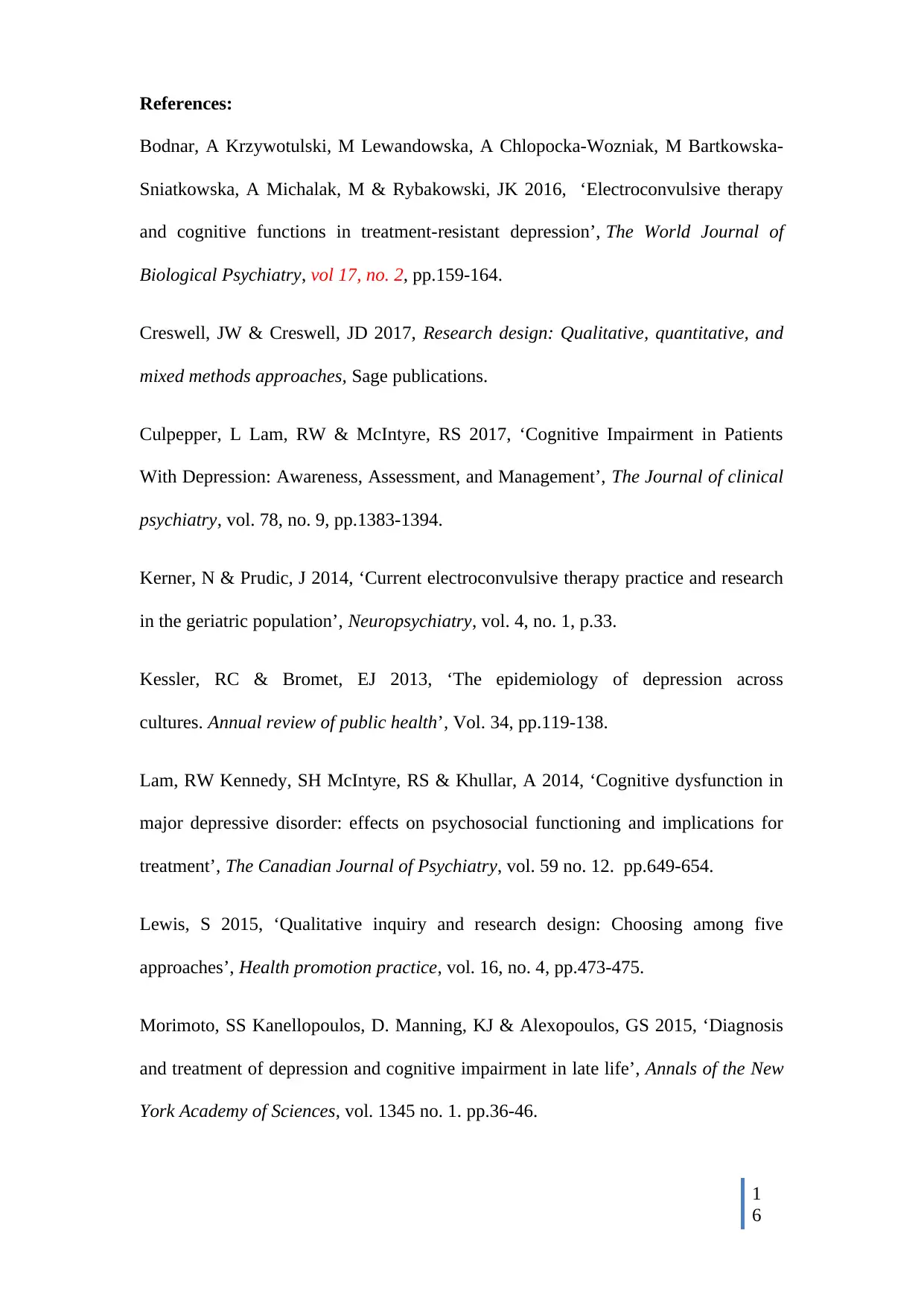
References:
Bodnar, A Krzywotulski, M Lewandowska, A Chlopocka-Wozniak, M Bartkowska-
Sniatkowska, A Michalak, M & Rybakowski, JK 2016, ‘Electroconvulsive therapy
and cognitive functions in treatment-resistant depression’, The World Journal of
Biological Psychiatry, vol 17, no. 2, pp.159-164.
Creswell, JW & Creswell, JD 2017, Research design: Qualitative, quantitative, and
mixed methods approaches, Sage publications.
Culpepper, L Lam, RW & McIntyre, RS 2017, ‘Cognitive Impairment in Patients
With Depression: Awareness, Assessment, and Management’, The Journal of clinical
psychiatry, vol. 78, no. 9, pp.1383-1394.
Kerner, N & Prudic, J 2014, ‘Current electroconvulsive therapy practice and research
in the geriatric population’, Neuropsychiatry, vol. 4, no. 1, p.33.
Kessler, RC & Bromet, EJ 2013, ‘The epidemiology of depression across
cultures. Annual review of public health’, Vol. 34, pp.119-138.
Lam, RW Kennedy, SH McIntyre, RS & Khullar, A 2014, ‘Cognitive dysfunction in
major depressive disorder: effects on psychosocial functioning and implications for
treatment’, The Canadian Journal of Psychiatry, vol. 59 no. 12. pp.649-654.
Lewis, S 2015, ‘Qualitative inquiry and research design: Choosing among five
approaches’, Health promotion practice, vol. 16, no. 4, pp.473-475.
Morimoto, SS Kanellopoulos, D. Manning, KJ & Alexopoulos, GS 2015, ‘Diagnosis
and treatment of depression and cognitive impairment in late life’, Annals of the New
York Academy of Sciences, vol. 1345 no. 1. pp.36-46.
1
6
Bodnar, A Krzywotulski, M Lewandowska, A Chlopocka-Wozniak, M Bartkowska-
Sniatkowska, A Michalak, M & Rybakowski, JK 2016, ‘Electroconvulsive therapy
and cognitive functions in treatment-resistant depression’, The World Journal of
Biological Psychiatry, vol 17, no. 2, pp.159-164.
Creswell, JW & Creswell, JD 2017, Research design: Qualitative, quantitative, and
mixed methods approaches, Sage publications.
Culpepper, L Lam, RW & McIntyre, RS 2017, ‘Cognitive Impairment in Patients
With Depression: Awareness, Assessment, and Management’, The Journal of clinical
psychiatry, vol. 78, no. 9, pp.1383-1394.
Kerner, N & Prudic, J 2014, ‘Current electroconvulsive therapy practice and research
in the geriatric population’, Neuropsychiatry, vol. 4, no. 1, p.33.
Kessler, RC & Bromet, EJ 2013, ‘The epidemiology of depression across
cultures. Annual review of public health’, Vol. 34, pp.119-138.
Lam, RW Kennedy, SH McIntyre, RS & Khullar, A 2014, ‘Cognitive dysfunction in
major depressive disorder: effects on psychosocial functioning and implications for
treatment’, The Canadian Journal of Psychiatry, vol. 59 no. 12. pp.649-654.
Lewis, S 2015, ‘Qualitative inquiry and research design: Choosing among five
approaches’, Health promotion practice, vol. 16, no. 4, pp.473-475.
Morimoto, SS Kanellopoulos, D. Manning, KJ & Alexopoulos, GS 2015, ‘Diagnosis
and treatment of depression and cognitive impairment in late life’, Annals of the New
York Academy of Sciences, vol. 1345 no. 1. pp.36-46.
1
6
Secure Best Marks with AI Grader
Need help grading? Try our AI Grader for instant feedback on your assignments.
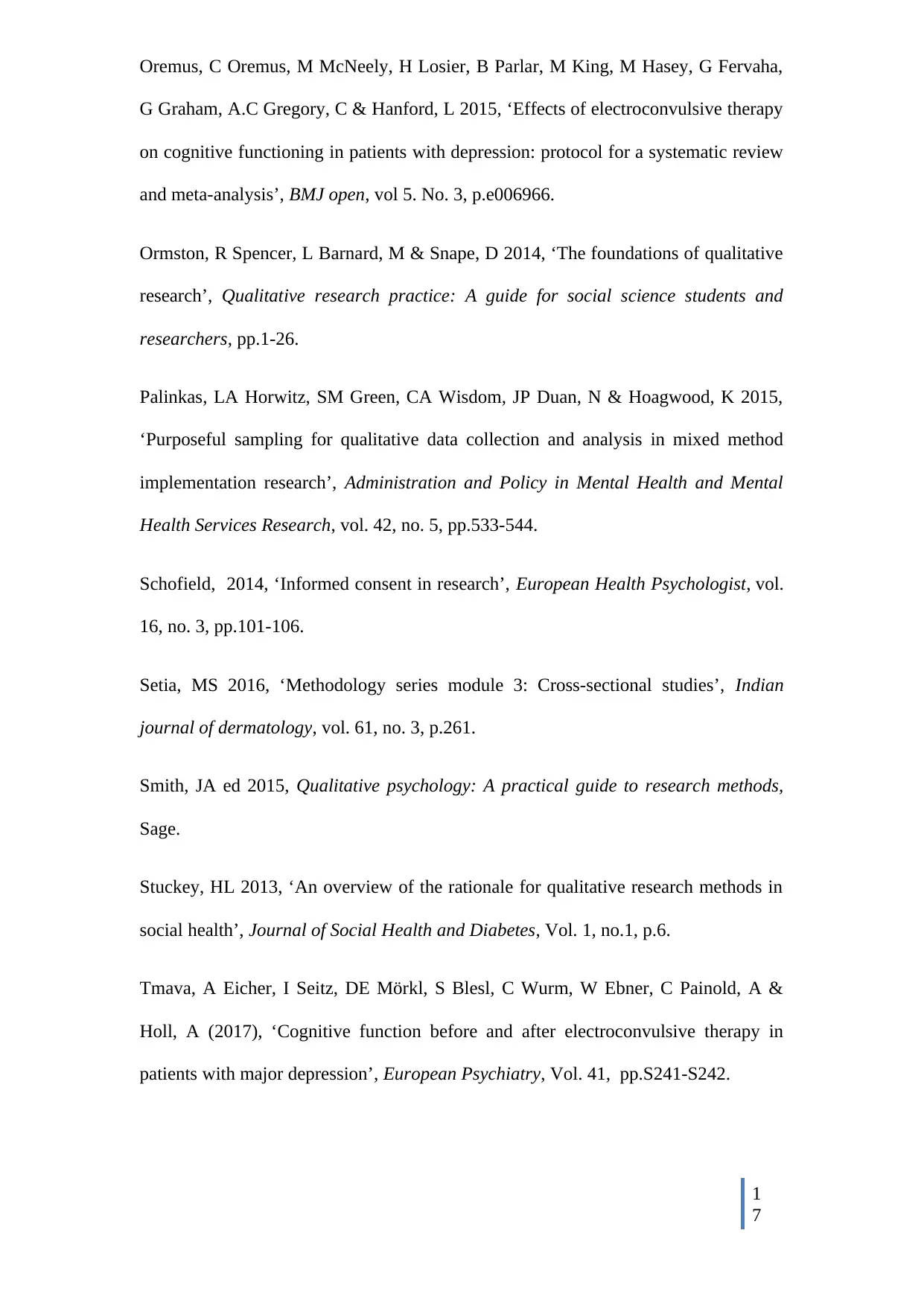
Oremus, C Oremus, M McNeely, H Losier, B Parlar, M King, M Hasey, G Fervaha,
G Graham, A.C Gregory, C & Hanford, L 2015, ‘Effects of electroconvulsive therapy
on cognitive functioning in patients with depression: protocol for a systematic review
and meta-analysis’, BMJ open, vol 5. No. 3, p.e006966.
Ormston, R Spencer, L Barnard, M & Snape, D 2014, ‘The foundations of qualitative
research’, Qualitative research practice: A guide for social science students and
researchers, pp.1-26.
Palinkas, LA Horwitz, SM Green, CA Wisdom, JP Duan, N & Hoagwood, K 2015,
‘Purposeful sampling for qualitative data collection and analysis in mixed method
implementation research’, Administration and Policy in Mental Health and Mental
Health Services Research, vol. 42, no. 5, pp.533-544.
Schofield, 2014, ‘Informed consent in research’, European Health Psychologist, vol.
16, no. 3, pp.101-106.
Setia, MS 2016, ‘Methodology series module 3: Cross-sectional studies’, Indian
journal of dermatology, vol. 61, no. 3, p.261.
Smith, JA ed 2015, Qualitative psychology: A practical guide to research methods,
Sage.
Stuckey, HL 2013, ‘An overview of the rationale for qualitative research methods in
social health’, Journal of Social Health and Diabetes, Vol. 1, no.1, p.6.
Tmava, A Eicher, I Seitz, DE Mörkl, S Blesl, C Wurm, W Ebner, C Painold, A &
Holl, A (2017), ‘Cognitive function before and after electroconvulsive therapy in
patients with major depression’, European Psychiatry, Vol. 41, pp.S241-S242.
1
7
G Graham, A.C Gregory, C & Hanford, L 2015, ‘Effects of electroconvulsive therapy
on cognitive functioning in patients with depression: protocol for a systematic review
and meta-analysis’, BMJ open, vol 5. No. 3, p.e006966.
Ormston, R Spencer, L Barnard, M & Snape, D 2014, ‘The foundations of qualitative
research’, Qualitative research practice: A guide for social science students and
researchers, pp.1-26.
Palinkas, LA Horwitz, SM Green, CA Wisdom, JP Duan, N & Hoagwood, K 2015,
‘Purposeful sampling for qualitative data collection and analysis in mixed method
implementation research’, Administration and Policy in Mental Health and Mental
Health Services Research, vol. 42, no. 5, pp.533-544.
Schofield, 2014, ‘Informed consent in research’, European Health Psychologist, vol.
16, no. 3, pp.101-106.
Setia, MS 2016, ‘Methodology series module 3: Cross-sectional studies’, Indian
journal of dermatology, vol. 61, no. 3, p.261.
Smith, JA ed 2015, Qualitative psychology: A practical guide to research methods,
Sage.
Stuckey, HL 2013, ‘An overview of the rationale for qualitative research methods in
social health’, Journal of Social Health and Diabetes, Vol. 1, no.1, p.6.
Tmava, A Eicher, I Seitz, DE Mörkl, S Blesl, C Wurm, W Ebner, C Painold, A &
Holl, A (2017), ‘Cognitive function before and after electroconvulsive therapy in
patients with major depression’, European Psychiatry, Vol. 41, pp.S241-S242.
1
7

Verwijk, E Comijs, HC Kok, RM Spaans, HP Tielkes, CE Scherder, EJ & Stek, ML
(2014), ‘Short-and long-term neurocognitive functioning after electroconvulsive
therapy in depressed elderly: a prospective naturalistic study’, International
psychogeriatrics, Vol. 26, no. 2, 315-324.
1
8
(2014), ‘Short-and long-term neurocognitive functioning after electroconvulsive
therapy in depressed elderly: a prospective naturalistic study’, International
psychogeriatrics, Vol. 26, no. 2, 315-324.
1
8
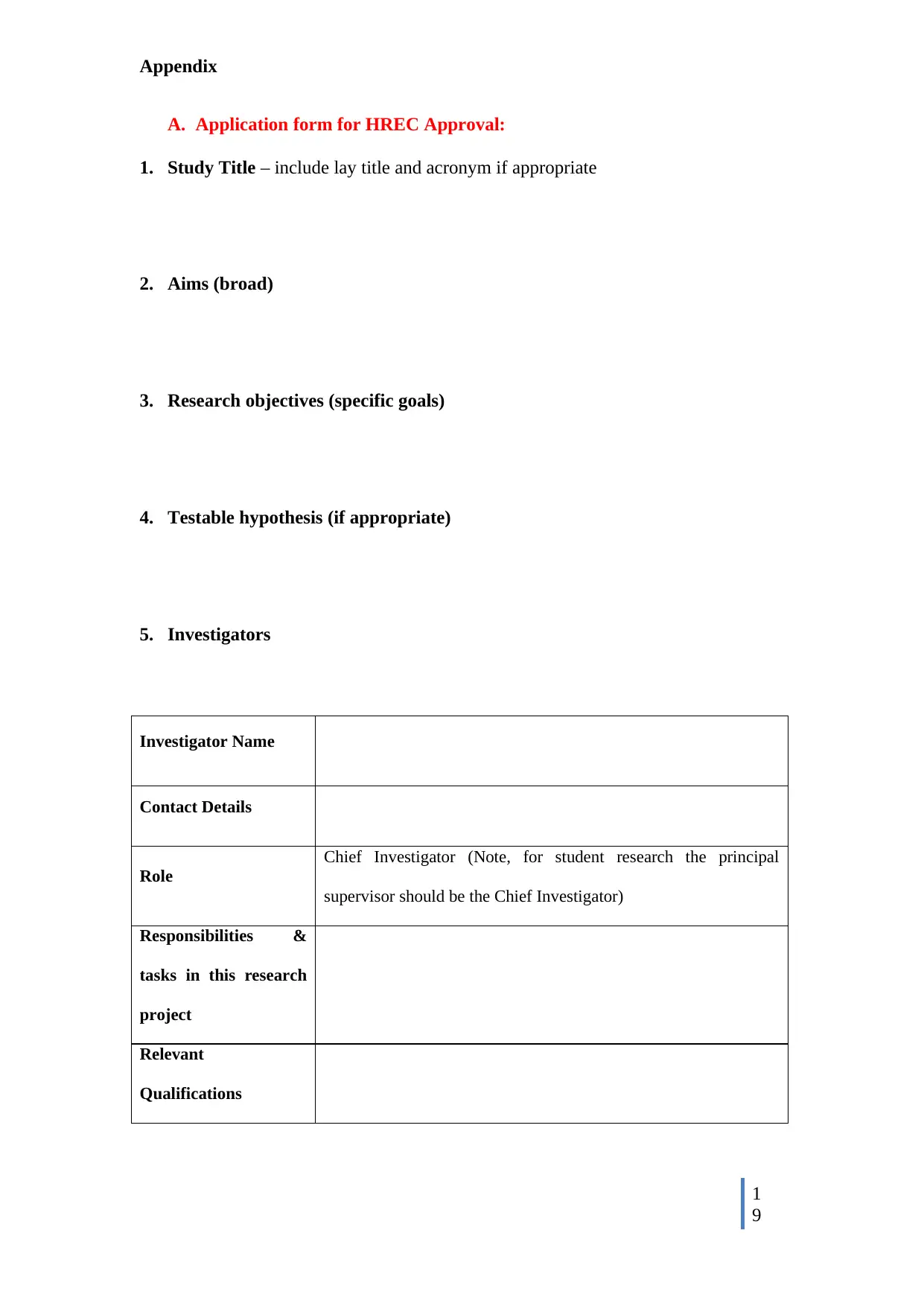
Appendix
A. Application form for HREC Approval:
1. Study Title – include lay title and acronym if appropriate
2. Aims (broad)
3. Research objectives (specific goals)
4. Testable hypothesis (if appropriate)
5. Investigators
Investigator Name
Contact Details
Role
Chief Investigator (Note, for student research the principal
supervisor should be the Chief Investigator)
Responsibilities &
tasks in this research
project
Relevant
Qualifications
1
9
A. Application form for HREC Approval:
1. Study Title – include lay title and acronym if appropriate
2. Aims (broad)
3. Research objectives (specific goals)
4. Testable hypothesis (if appropriate)
5. Investigators
Investigator Name
Contact Details
Role
Chief Investigator (Note, for student research the principal
supervisor should be the Chief Investigator)
Responsibilities &
tasks in this research
project
Relevant
Qualifications
1
9
Paraphrase This Document
Need a fresh take? Get an instant paraphrase of this document with our AI Paraphraser
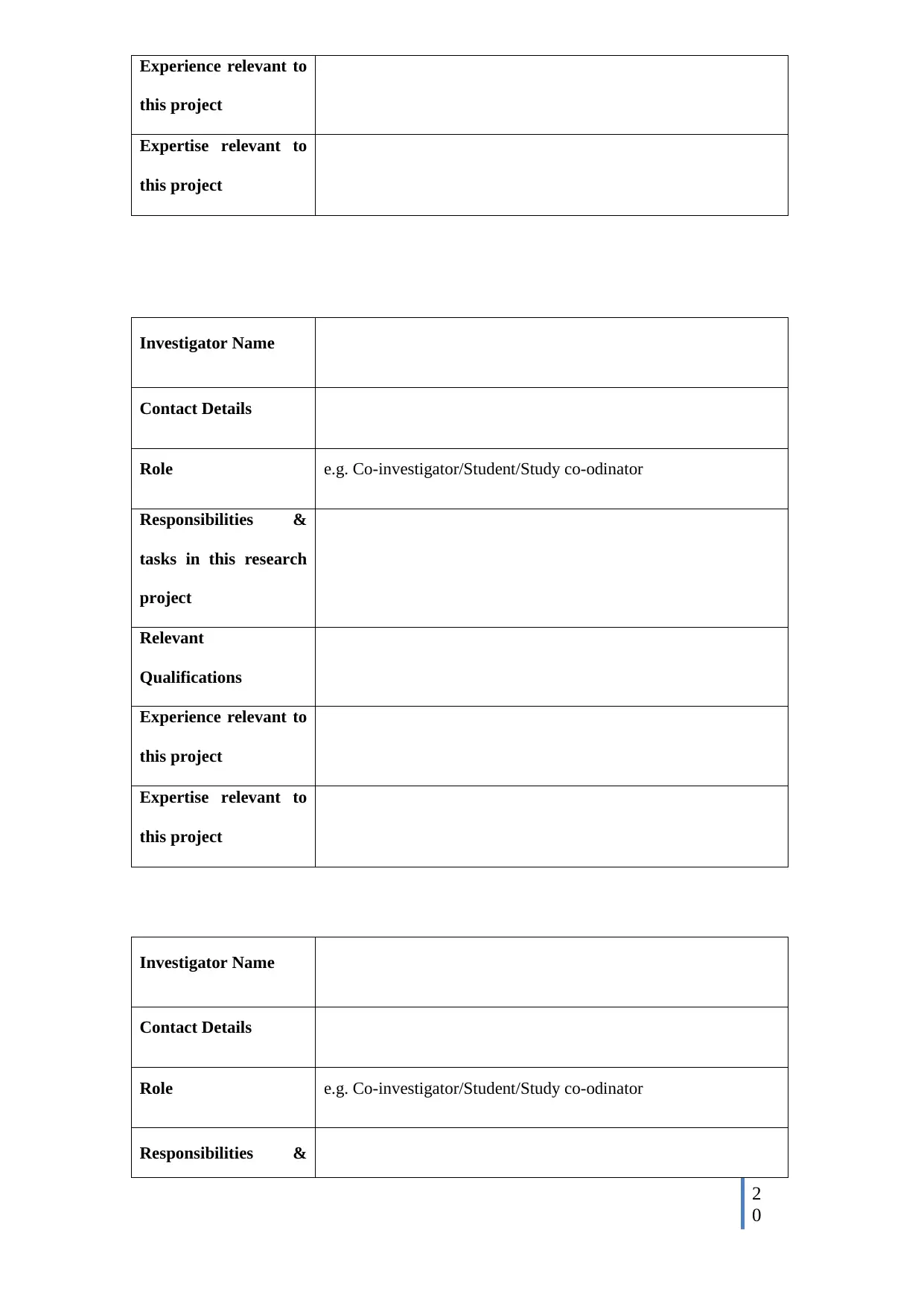
Experience relevant to
this project
Expertise relevant to
this project
Investigator Name
Contact Details
Role e.g. Co-investigator/Student/Study co-odinator
Responsibilities &
tasks in this research
project
Relevant
Qualifications
Experience relevant to
this project
Expertise relevant to
this project
Investigator Name
Contact Details
Role e.g. Co-investigator/Student/Study co-odinator
Responsibilities &
2
0
this project
Expertise relevant to
this project
Investigator Name
Contact Details
Role e.g. Co-investigator/Student/Study co-odinator
Responsibilities &
tasks in this research
project
Relevant
Qualifications
Experience relevant to
this project
Expertise relevant to
this project
Investigator Name
Contact Details
Role e.g. Co-investigator/Student/Study co-odinator
Responsibilities &
2
0
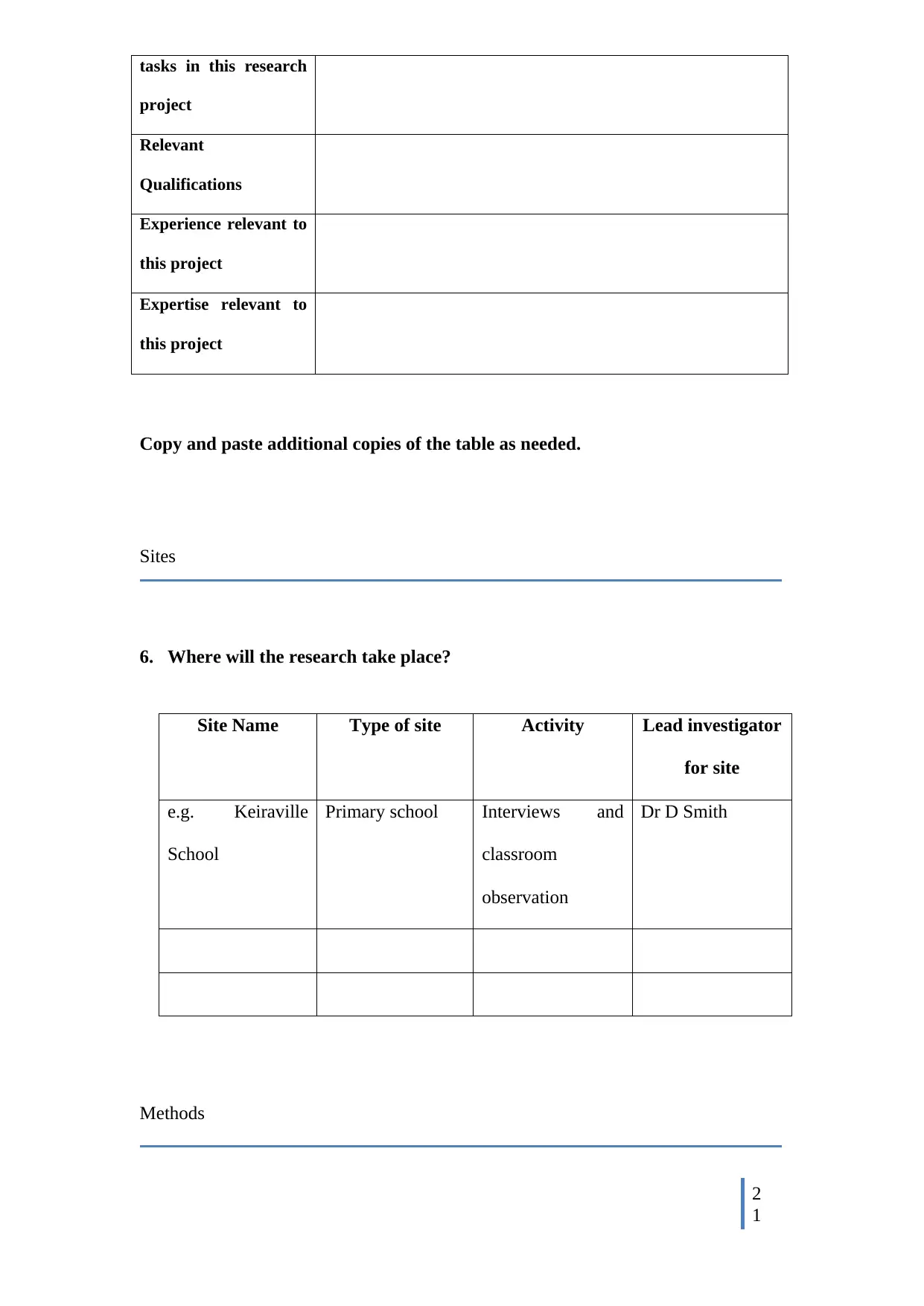
tasks in this research
project
Relevant
Qualifications
Experience relevant to
this project
Expertise relevant to
this project
Copy and paste additional copies of the table as needed.
Sites
6. Where will the research take place?
Site Name Type of site Activity Lead investigator
for site
e.g. Keiraville
School
Primary school Interviews and
classroom
observation
Dr D Smith
Methods
2
1
project
Relevant
Qualifications
Experience relevant to
this project
Expertise relevant to
this project
Copy and paste additional copies of the table as needed.
Sites
6. Where will the research take place?
Site Name Type of site Activity Lead investigator
for site
e.g. Keiraville
School
Primary school Interviews and
classroom
observation
Dr D Smith
Methods
2
1
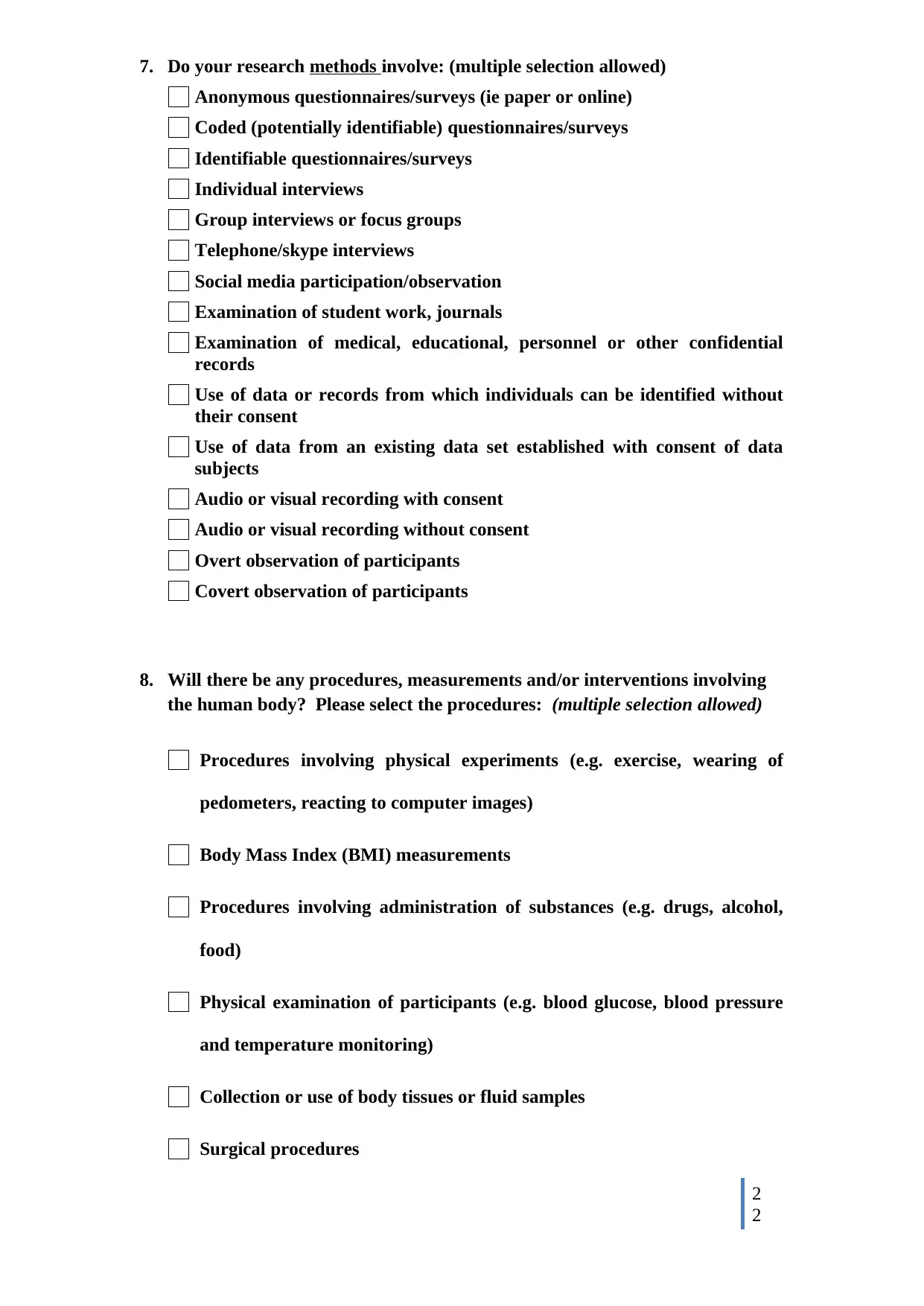
7. Do your research methods involve: (multiple selection allowed)
Anonymous questionnaires/surveys (ie paper or online)
Coded (potentially identifiable) questionnaires/surveys
Identifiable questionnaires/surveys
Individual interviews
Group interviews or focus groups
Telephone/skype interviews
Social media participation/observation
Examination of student work, journals
Examination of medical, educational, personnel or other confidential
records
Use of data or records from which individuals can be identified without
their consent
Use of data from an existing data set established with consent of data
subjects
Audio or visual recording with consent
Audio or visual recording without consent
Overt observation of participants
Covert observation of participants
8. Will there be any procedures, measurements and/or interventions involving
the human body? Please select the procedures: (multiple selection allowed)
Procedures involving physical experiments (e.g. exercise, wearing of
pedometers, reacting to computer images)
Body Mass Index (BMI) measurements
Procedures involving administration of substances (e.g. drugs, alcohol,
food)
Physical examination of participants (e.g. blood glucose, blood pressure
and temperature monitoring)
Collection or use of body tissues or fluid samples
Surgical procedures
2
2
Anonymous questionnaires/surveys (ie paper or online)
Coded (potentially identifiable) questionnaires/surveys
Identifiable questionnaires/surveys
Individual interviews
Group interviews or focus groups
Telephone/skype interviews
Social media participation/observation
Examination of student work, journals
Examination of medical, educational, personnel or other confidential
records
Use of data or records from which individuals can be identified without
their consent
Use of data from an existing data set established with consent of data
subjects
Audio or visual recording with consent
Audio or visual recording without consent
Overt observation of participants
Covert observation of participants
8. Will there be any procedures, measurements and/or interventions involving
the human body? Please select the procedures: (multiple selection allowed)
Procedures involving physical experiments (e.g. exercise, wearing of
pedometers, reacting to computer images)
Body Mass Index (BMI) measurements
Procedures involving administration of substances (e.g. drugs, alcohol,
food)
Physical examination of participants (e.g. blood glucose, blood pressure
and temperature monitoring)
Collection or use of body tissues or fluid samples
Surgical procedures
2
2
Secure Best Marks with AI Grader
Need help grading? Try our AI Grader for instant feedback on your assignments.
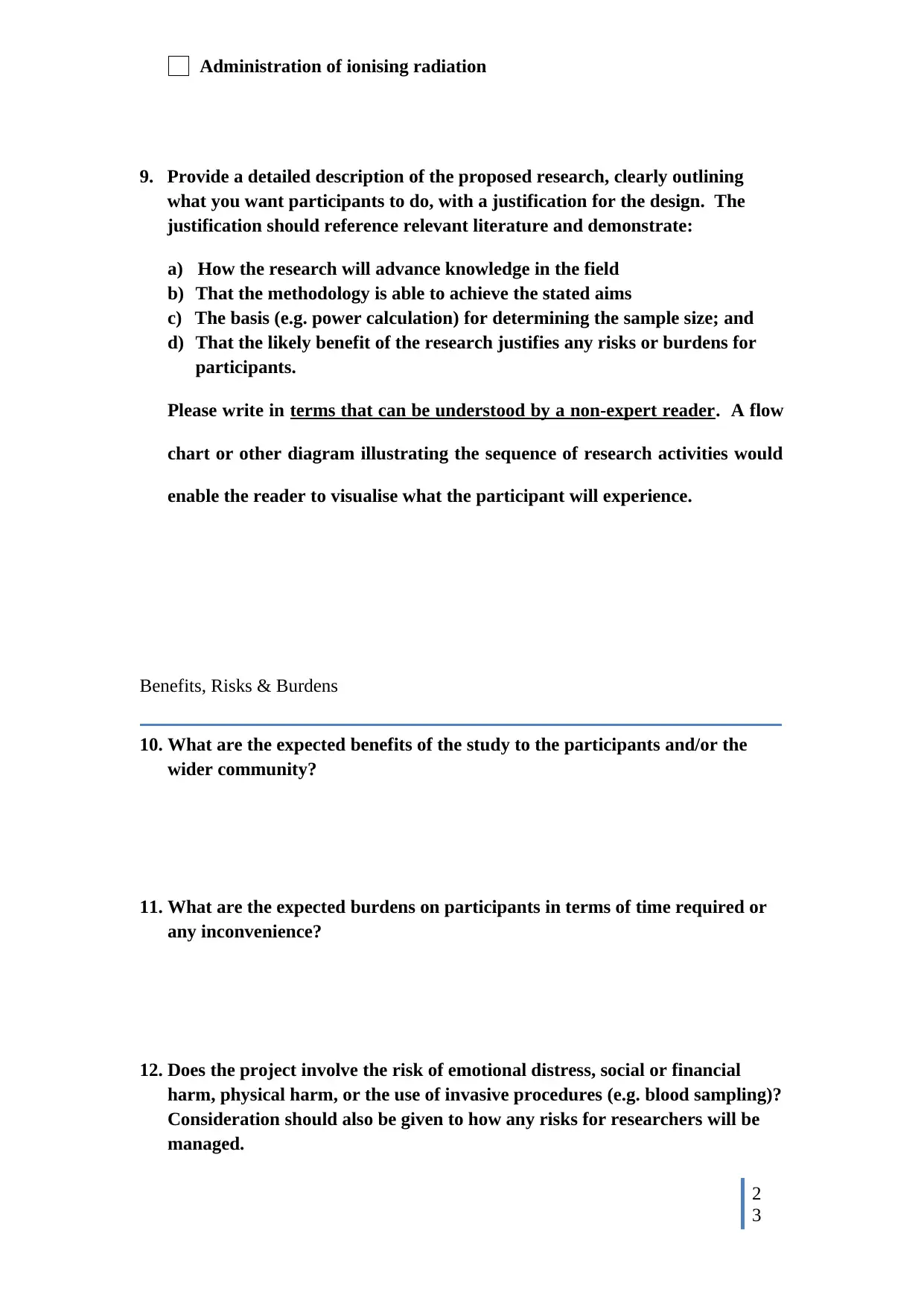
Administration of ionising radiation
9. Provide a detailed description of the proposed research, clearly outlining
what you want participants to do, with a justification for the design. The
justification should reference relevant literature and demonstrate:
a) How the research will advance knowledge in the field
b) That the methodology is able to achieve the stated aims
c) The basis (e.g. power calculation) for determining the sample size; and
d) That the likely benefit of the research justifies any risks or burdens for
participants.
Please write in terms that can be understood by a non-expert reader. A flow
chart or other diagram illustrating the sequence of research activities would
enable the reader to visualise what the participant will experience.
Benefits, Risks & Burdens
10. What are the expected benefits of the study to the participants and/or the
wider community?
11. What are the expected burdens on participants in terms of time required or
any inconvenience?
12. Does the project involve the risk of emotional distress, social or financial
harm, physical harm, or the use of invasive procedures (e.g. blood sampling)?
Consideration should also be given to how any risks for researchers will be
managed.
2
3
9. Provide a detailed description of the proposed research, clearly outlining
what you want participants to do, with a justification for the design. The
justification should reference relevant literature and demonstrate:
a) How the research will advance knowledge in the field
b) That the methodology is able to achieve the stated aims
c) The basis (e.g. power calculation) for determining the sample size; and
d) That the likely benefit of the research justifies any risks or burdens for
participants.
Please write in terms that can be understood by a non-expert reader. A flow
chart or other diagram illustrating the sequence of research activities would
enable the reader to visualise what the participant will experience.
Benefits, Risks & Burdens
10. What are the expected benefits of the study to the participants and/or the
wider community?
11. What are the expected burdens on participants in terms of time required or
any inconvenience?
12. Does the project involve the risk of emotional distress, social or financial
harm, physical harm, or the use of invasive procedures (e.g. blood sampling)?
Consideration should also be given to how any risks for researchers will be
managed.
2
3
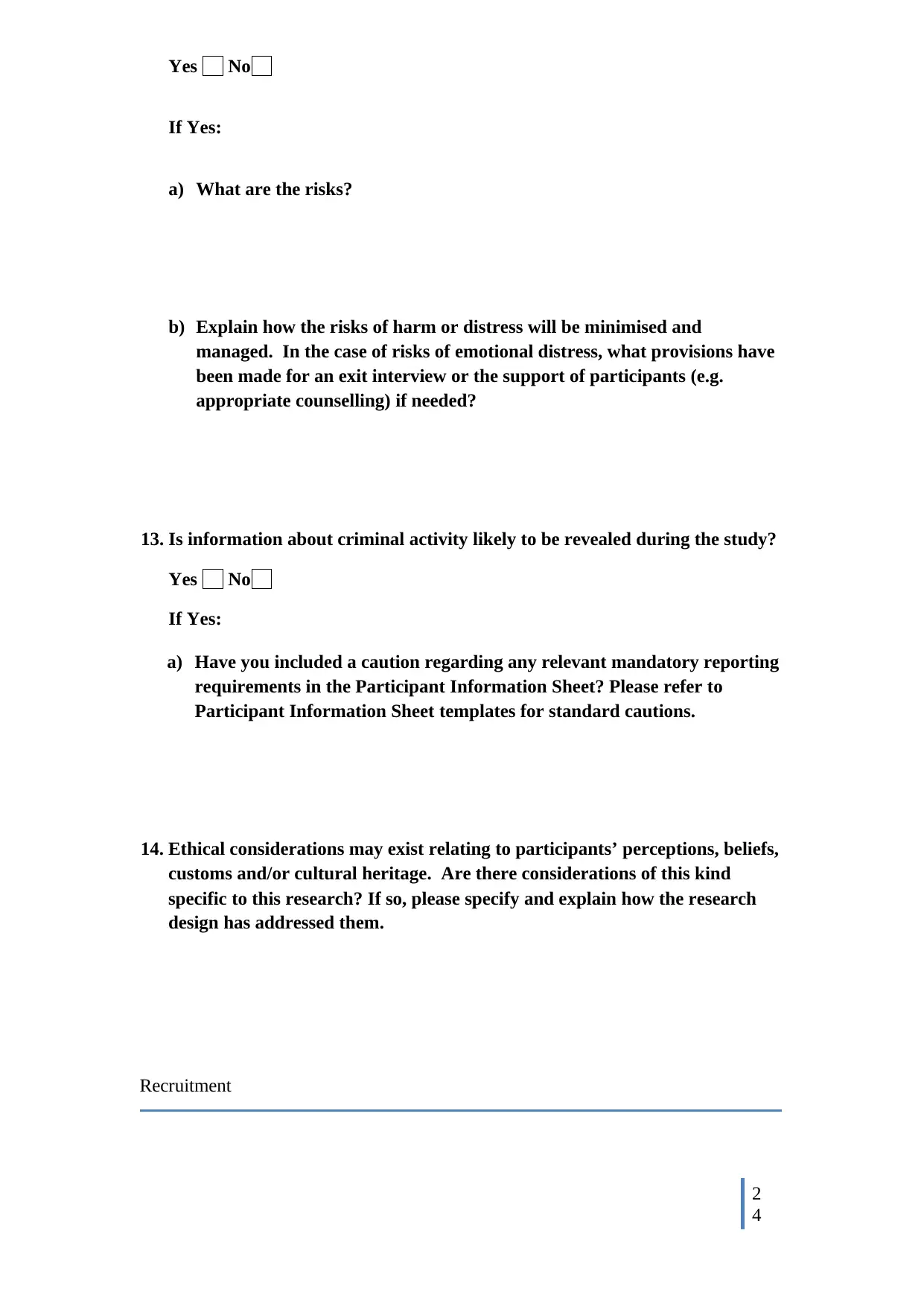
Yes No
If Yes:
a) What are the risks?
b) Explain how the risks of harm or distress will be minimised and
managed. In the case of risks of emotional distress, what provisions have
been made for an exit interview or the support of participants (e.g.
appropriate counselling) if needed?
13. Is information about criminal activity likely to be revealed during the study?
Yes No
If Yes:
a) Have you included a caution regarding any relevant mandatory reporting
requirements in the Participant Information Sheet? Please refer to
Participant Information Sheet templates for standard cautions.
14. Ethical considerations may exist relating to participants’ perceptions, beliefs,
customs and/or cultural heritage. Are there considerations of this kind
specific to this research? If so, please specify and explain how the research
design has addressed them.
Recruitment
2
4
If Yes:
a) What are the risks?
b) Explain how the risks of harm or distress will be minimised and
managed. In the case of risks of emotional distress, what provisions have
been made for an exit interview or the support of participants (e.g.
appropriate counselling) if needed?
13. Is information about criminal activity likely to be revealed during the study?
Yes No
If Yes:
a) Have you included a caution regarding any relevant mandatory reporting
requirements in the Participant Information Sheet? Please refer to
Participant Information Sheet templates for standard cautions.
14. Ethical considerations may exist relating to participants’ perceptions, beliefs,
customs and/or cultural heritage. Are there considerations of this kind
specific to this research? If so, please specify and explain how the research
design has addressed them.
Recruitment
2
4
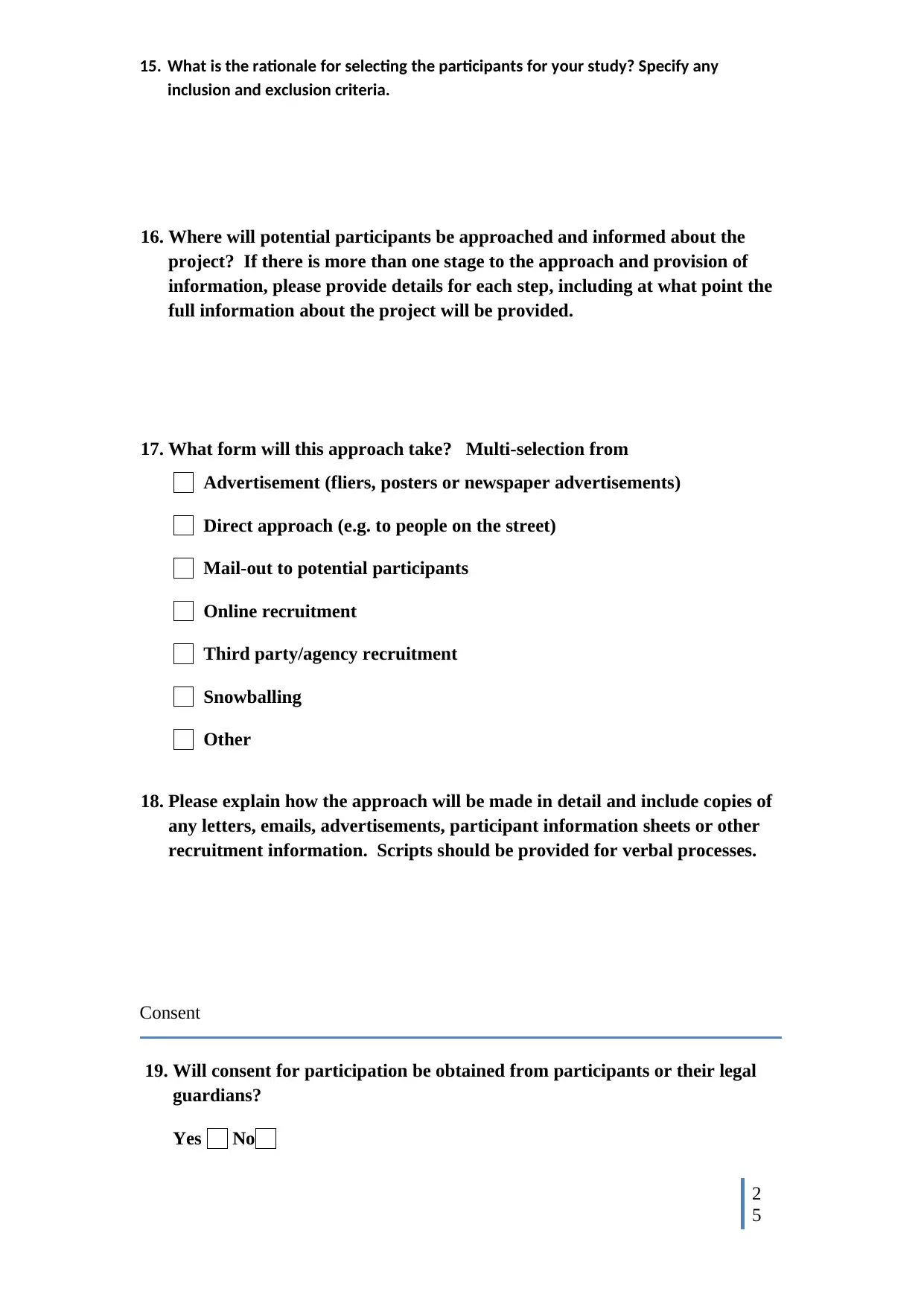
15. What is the rationale for selecting the participants for your study? Specify any
inclusion and exclusion criteria.
16. Where will potential participants be approached and informed about the
project? If there is more than one stage to the approach and provision of
information, please provide details for each step, including at what point the
full information about the project will be provided.
17. What form will this approach take? Multi-selection from
Advertisement (fliers, posters or newspaper advertisements)
Direct approach (e.g. to people on the street)
Mail-out to potential participants
Online recruitment
Third party/agency recruitment
Snowballing
Other
18. Please explain how the approach will be made in detail and include copies of
any letters, emails, advertisements, participant information sheets or other
recruitment information. Scripts should be provided for verbal processes.
Consent
19. Will consent for participation be obtained from participants or their legal
guardians?
Yes No
2
5
inclusion and exclusion criteria.
16. Where will potential participants be approached and informed about the
project? If there is more than one stage to the approach and provision of
information, please provide details for each step, including at what point the
full information about the project will be provided.
17. What form will this approach take? Multi-selection from
Advertisement (fliers, posters or newspaper advertisements)
Direct approach (e.g. to people on the street)
Mail-out to potential participants
Online recruitment
Third party/agency recruitment
Snowballing
Other
18. Please explain how the approach will be made in detail and include copies of
any letters, emails, advertisements, participant information sheets or other
recruitment information. Scripts should be provided for verbal processes.
Consent
19. Will consent for participation be obtained from participants or their legal
guardians?
Yes No
2
5
Paraphrase This Document
Need a fresh take? Get an instant paraphrase of this document with our AI Paraphraser
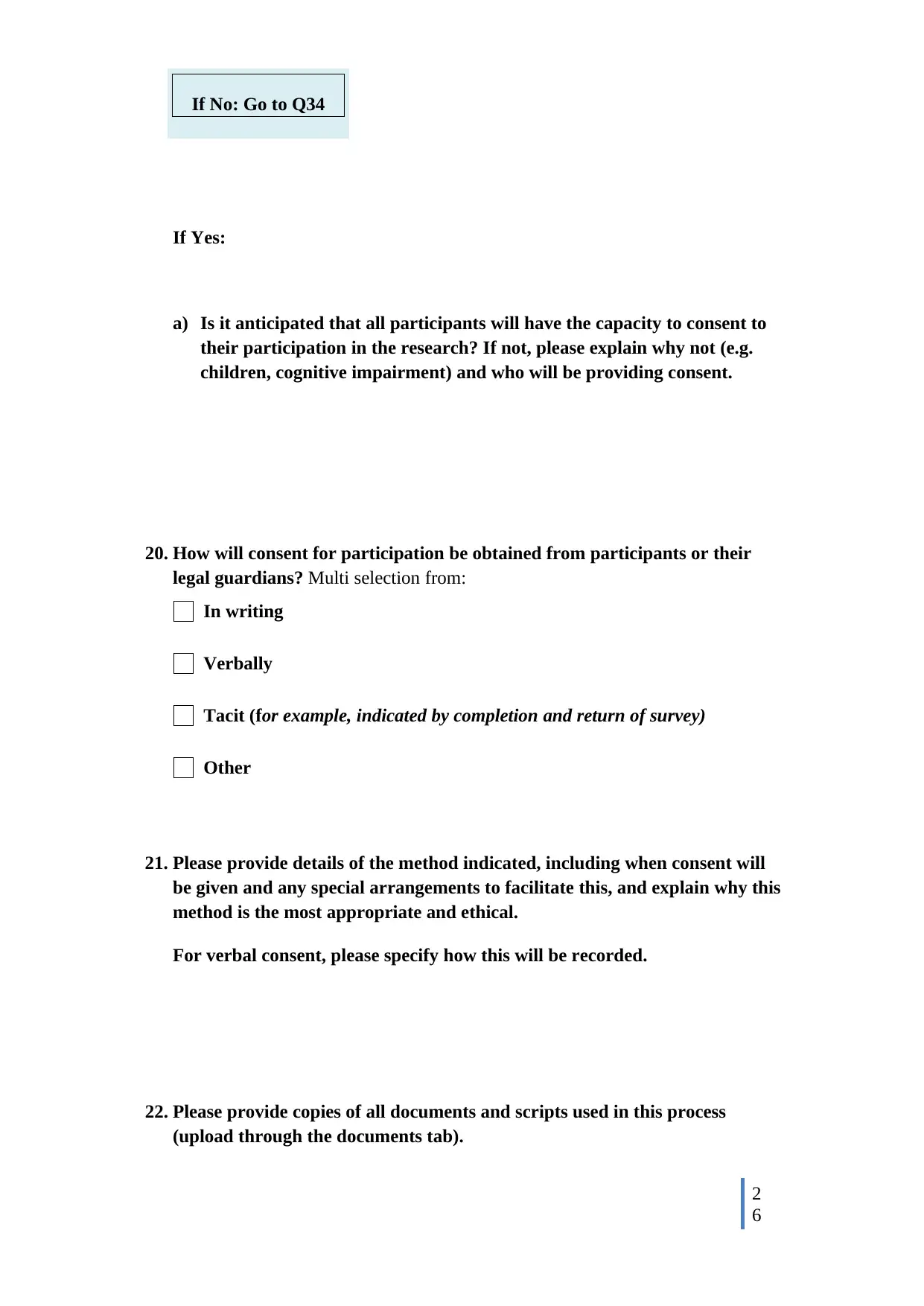
If Yes:
a) Is it anticipated that all participants will have the capacity to consent to
their participation in the research? If not, please explain why not (e.g.
children, cognitive impairment) and who will be providing consent.
20. How will consent for participation be obtained from participants or their
legal guardians? Multi selection from:
In writing
Verbally
Tacit (for example, indicated by completion and return of survey)
Other
21. Please provide details of the method indicated, including when consent will
be given and any special arrangements to facilitate this, and explain why this
method is the most appropriate and ethical.
For verbal consent, please specify how this will be recorded.
22. Please provide copies of all documents and scripts used in this process
(upload through the documents tab).
2
6
If No: Go to Q34
a) Is it anticipated that all participants will have the capacity to consent to
their participation in the research? If not, please explain why not (e.g.
children, cognitive impairment) and who will be providing consent.
20. How will consent for participation be obtained from participants or their
legal guardians? Multi selection from:
In writing
Verbally
Tacit (for example, indicated by completion and return of survey)
Other
21. Please provide details of the method indicated, including when consent will
be given and any special arrangements to facilitate this, and explain why this
method is the most appropriate and ethical.
For verbal consent, please specify how this will be recorded.
22. Please provide copies of all documents and scripts used in this process
(upload through the documents tab).
2
6
If No: Go to Q34
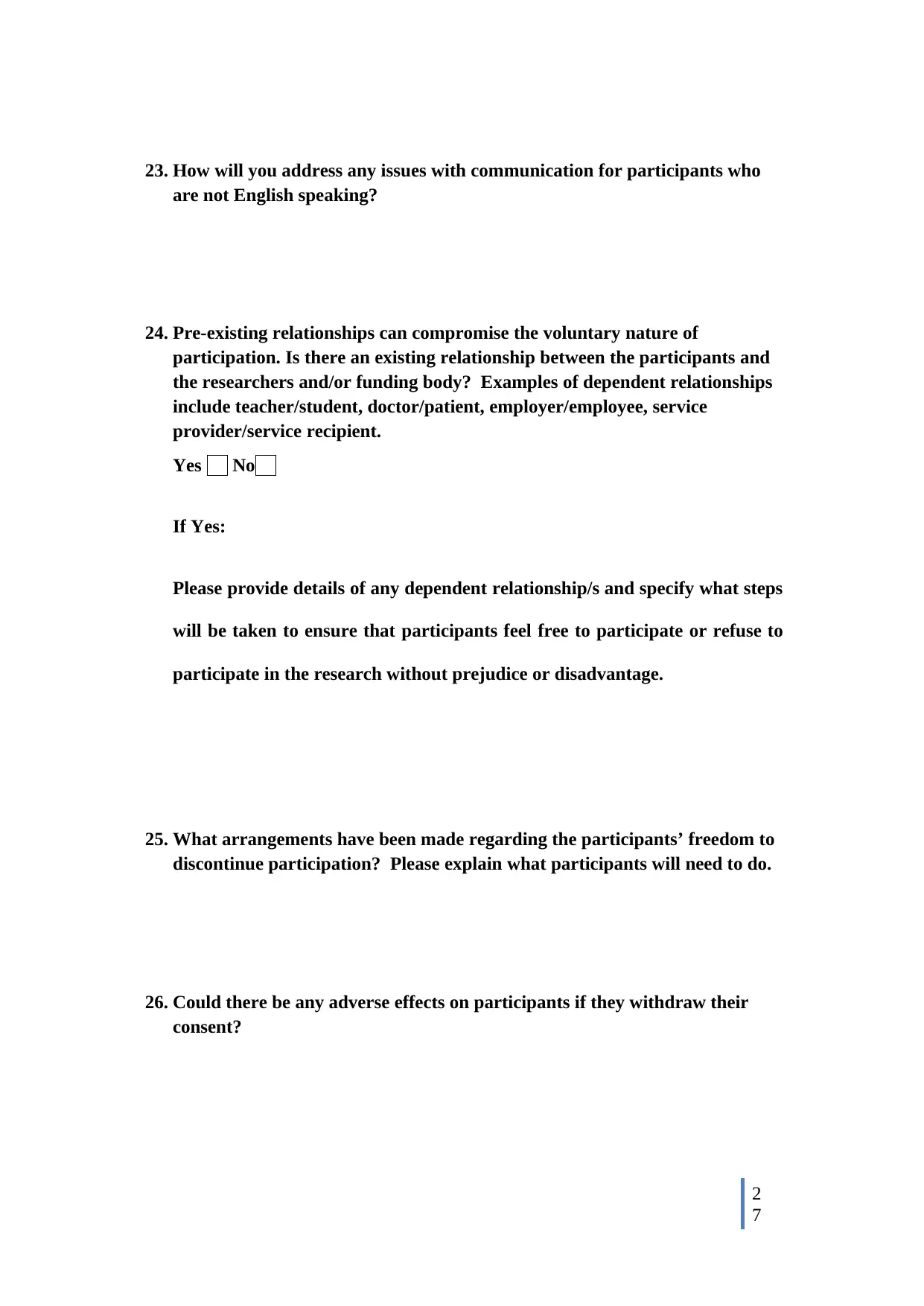
23. How will you address any issues with communication for participants who
are not English speaking?
24. Pre-existing relationships can compromise the voluntary nature of
participation. Is there an existing relationship between the participants and
the researchers and/or funding body? Examples of dependent relationships
include teacher/student, doctor/patient, employer/employee, service
provider/service recipient.
Yes No
If Yes:
Please provide details of any dependent relationship/s and specify what steps
will be taken to ensure that participants feel free to participate or refuse to
participate in the research without prejudice or disadvantage.
25. What arrangements have been made regarding the participants’ freedom to
discontinue participation? Please explain what participants will need to do.
26. Could there be any adverse effects on participants if they withdraw their
consent?
2
7
are not English speaking?
24. Pre-existing relationships can compromise the voluntary nature of
participation. Is there an existing relationship between the participants and
the researchers and/or funding body? Examples of dependent relationships
include teacher/student, doctor/patient, employer/employee, service
provider/service recipient.
Yes No
If Yes:
Please provide details of any dependent relationship/s and specify what steps
will be taken to ensure that participants feel free to participate or refuse to
participate in the research without prejudice or disadvantage.
25. What arrangements have been made regarding the participants’ freedom to
discontinue participation? Please explain what participants will need to do.
26. Could there be any adverse effects on participants if they withdraw their
consent?
2
7
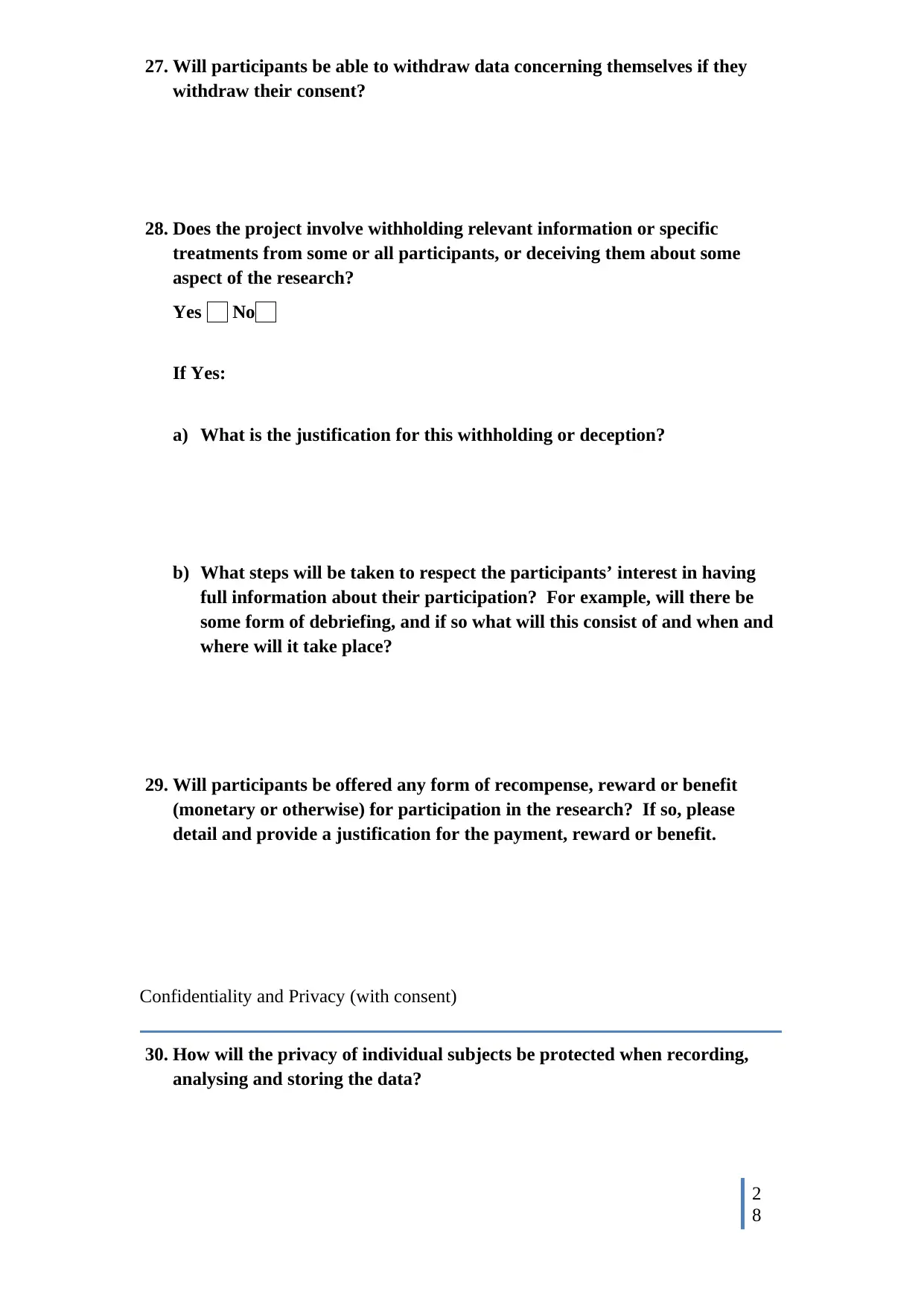
27. Will participants be able to withdraw data concerning themselves if they
withdraw their consent?
28. Does the project involve withholding relevant information or specific
treatments from some or all participants, or deceiving them about some
aspect of the research?
Yes No
If Yes:
a) What is the justification for this withholding or deception?
b) What steps will be taken to respect the participants’ interest in having
full information about their participation? For example, will there be
some form of debriefing, and if so what will this consist of and when and
where will it take place?
29. Will participants be offered any form of recompense, reward or benefit
(monetary or otherwise) for participation in the research? If so, please
detail and provide a justification for the payment, reward or benefit.
Confidentiality and Privacy (with consent)
30. How will the privacy of individual subjects be protected when recording,
analysing and storing the data?
2
8
withdraw their consent?
28. Does the project involve withholding relevant information or specific
treatments from some or all participants, or deceiving them about some
aspect of the research?
Yes No
If Yes:
a) What is the justification for this withholding or deception?
b) What steps will be taken to respect the participants’ interest in having
full information about their participation? For example, will there be
some form of debriefing, and if so what will this consist of and when and
where will it take place?
29. Will participants be offered any form of recompense, reward or benefit
(monetary or otherwise) for participation in the research? If so, please
detail and provide a justification for the payment, reward or benefit.
Confidentiality and Privacy (with consent)
30. How will the privacy of individual subjects be protected when recording,
analysing and storing the data?
2
8
Secure Best Marks with AI Grader
Need help grading? Try our AI Grader for instant feedback on your assignments.
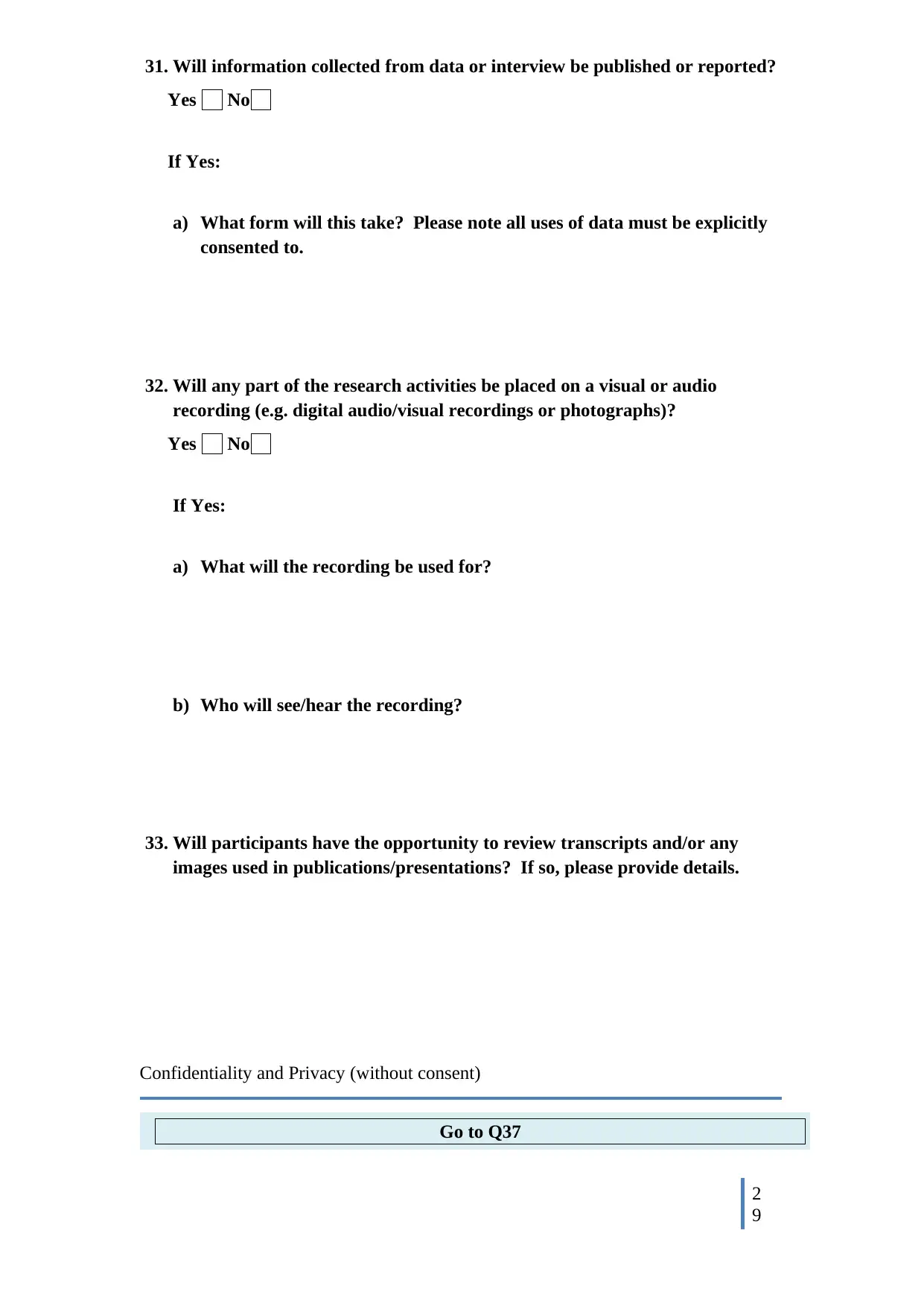
31. Will information collected from data or interview be published or reported?
Yes No
If Yes:
a) What form will this take? Please note all uses of data must be explicitly
consented to.
32. Will any part of the research activities be placed on a visual or audio
recording (e.g. digital audio/visual recordings or photographs)?
Yes No
If Yes:
a) What will the recording be used for?
b) Who will see/hear the recording?
33. Will participants have the opportunity to review transcripts and/or any
images used in publications/presentations? If so, please provide details.
Confidentiality and Privacy (without consent)
2
9
Go to Q37
Yes No
If Yes:
a) What form will this take? Please note all uses of data must be explicitly
consented to.
32. Will any part of the research activities be placed on a visual or audio
recording (e.g. digital audio/visual recordings or photographs)?
Yes No
If Yes:
a) What will the recording be used for?
b) Who will see/hear the recording?
33. Will participants have the opportunity to review transcripts and/or any
images used in publications/presentations? If so, please provide details.
Confidentiality and Privacy (without consent)
2
9
Go to Q37
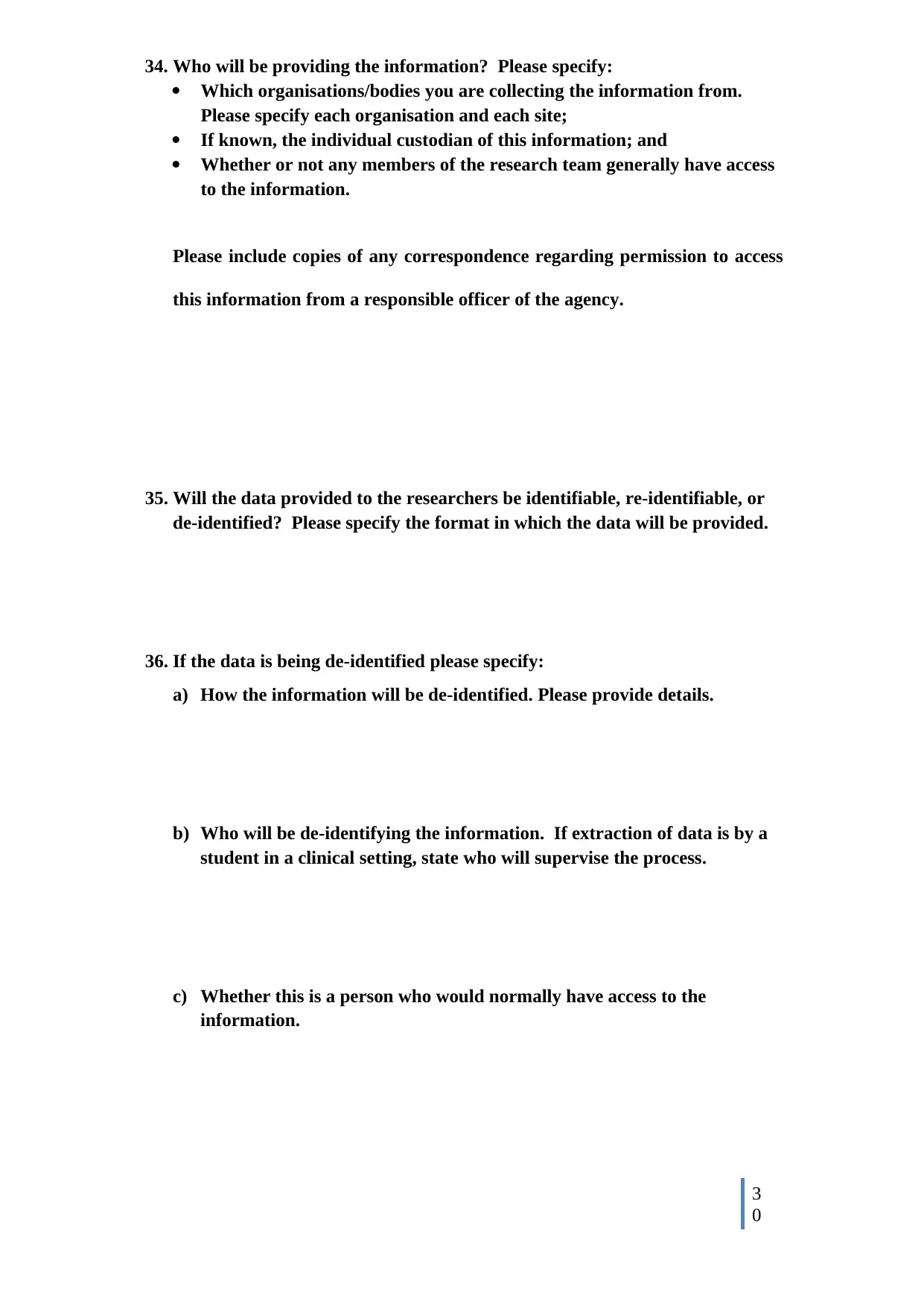
34. Who will be providing the information? Please specify:
Which organisations/bodies you are collecting the information from.
Please specify each organisation and each site;
If known, the individual custodian of this information; and
Whether or not any members of the research team generally have access
to the information.
Please include copies of any correspondence regarding permission to access
this information from a responsible officer of the agency.
35. Will the data provided to the researchers be identifiable, re-identifiable, or
de-identified? Please specify the format in which the data will be provided.
36. If the data is being de-identified please specify:
a) How the information will be de-identified. Please provide details.
b) Who will be de-identifying the information. If extraction of data is by a
student in a clinical setting, state who will supervise the process.
c) Whether this is a person who would normally have access to the
information.
3
0
Which organisations/bodies you are collecting the information from.
Please specify each organisation and each site;
If known, the individual custodian of this information; and
Whether or not any members of the research team generally have access
to the information.
Please include copies of any correspondence regarding permission to access
this information from a responsible officer of the agency.
35. Will the data provided to the researchers be identifiable, re-identifiable, or
de-identified? Please specify the format in which the data will be provided.
36. If the data is being de-identified please specify:
a) How the information will be de-identified. Please provide details.
b) Who will be de-identifying the information. If extraction of data is by a
student in a clinical setting, state who will supervise the process.
c) Whether this is a person who would normally have access to the
information.
3
0
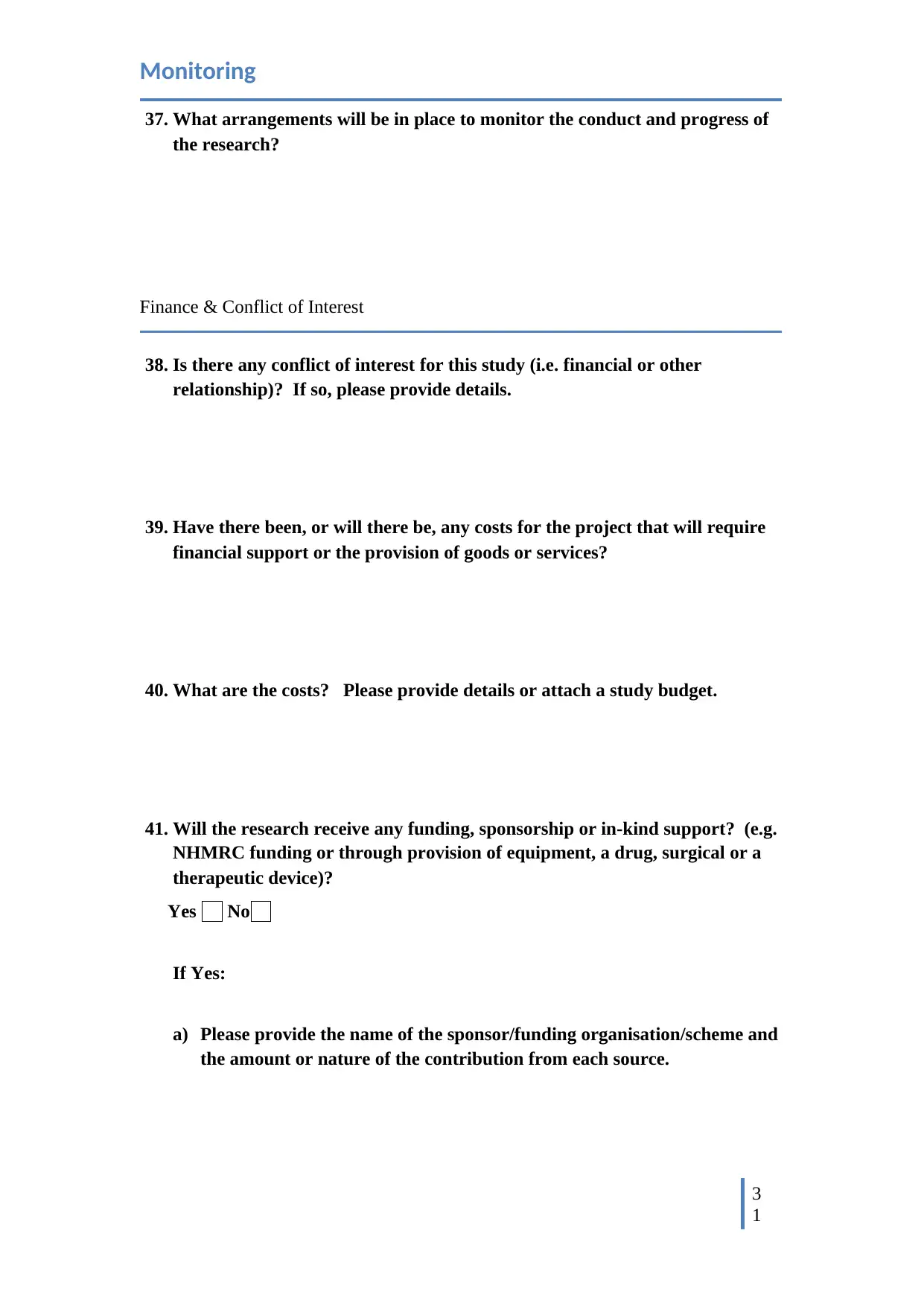
Monitoring
37. What arrangements will be in place to monitor the conduct and progress of
the research?
Finance & Conflict of Interest
38. Is there any conflict of interest for this study (i.e. financial or other
relationship)? If so, please provide details.
39. Have there been, or will there be, any costs for the project that will require
financial support or the provision of goods or services?
40. What are the costs? Please provide details or attach a study budget.
41. Will the research receive any funding, sponsorship or in-kind support? (e.g.
NHMRC funding or through provision of equipment, a drug, surgical or a
therapeutic device)?
Yes No
If Yes:
a) Please provide the name of the sponsor/funding organisation/scheme and
the amount or nature of the contribution from each source.
3
1
37. What arrangements will be in place to monitor the conduct and progress of
the research?
Finance & Conflict of Interest
38. Is there any conflict of interest for this study (i.e. financial or other
relationship)? If so, please provide details.
39. Have there been, or will there be, any costs for the project that will require
financial support or the provision of goods or services?
40. What are the costs? Please provide details or attach a study budget.
41. Will the research receive any funding, sponsorship or in-kind support? (e.g.
NHMRC funding or through provision of equipment, a drug, surgical or a
therapeutic device)?
Yes No
If Yes:
a) Please provide the name of the sponsor/funding organisation/scheme and
the amount or nature of the contribution from each source.
3
1
Paraphrase This Document
Need a fresh take? Get an instant paraphrase of this document with our AI Paraphraser
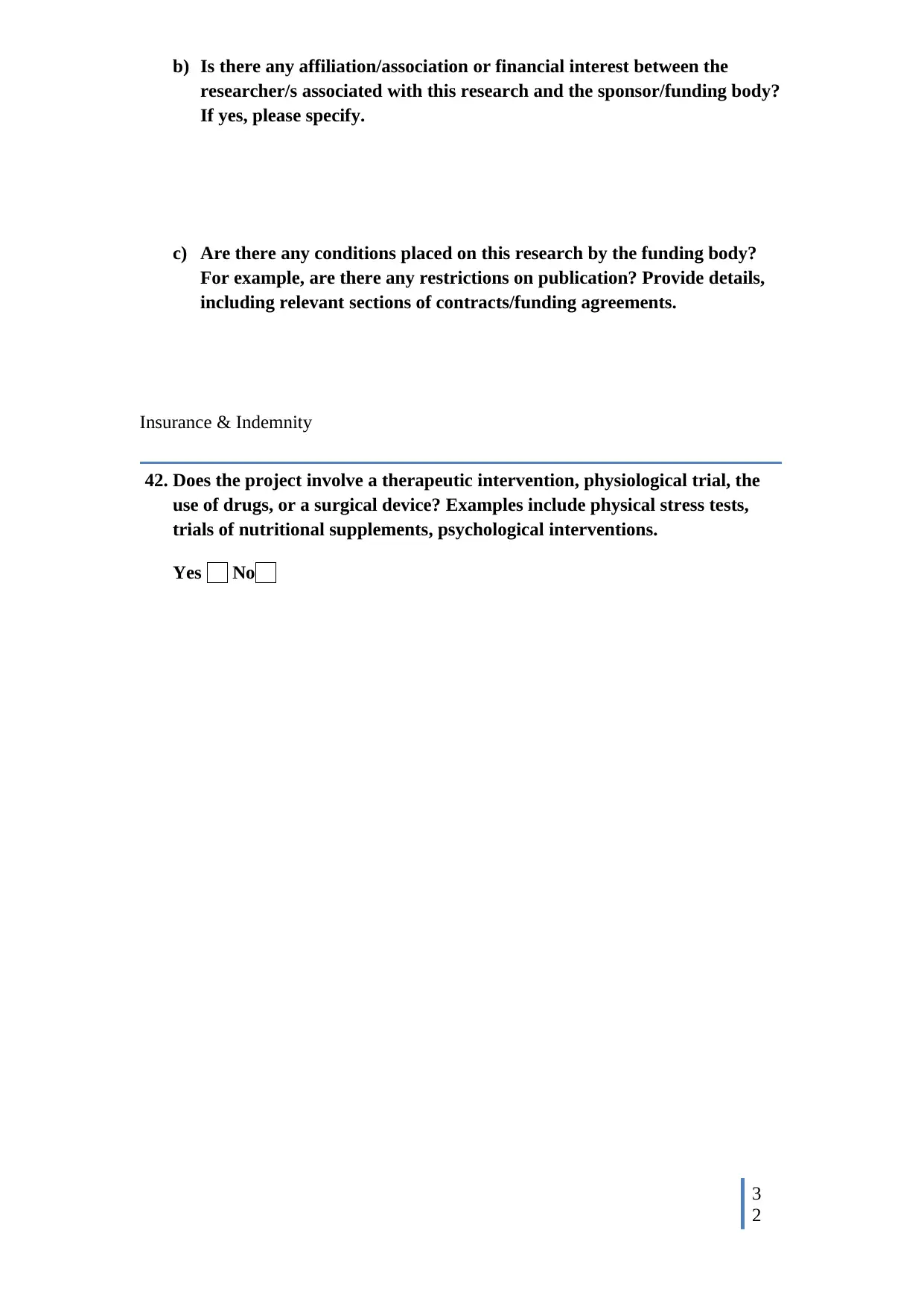
b) Is there any affiliation/association or financial interest between the
researcher/s associated with this research and the sponsor/funding body?
If yes, please specify.
c) Are there any conditions placed on this research by the funding body?
For example, are there any restrictions on publication? Provide details,
including relevant sections of contracts/funding agreements.
Insurance & Indemnity
42. Does the project involve a therapeutic intervention, physiological trial, the
use of drugs, or a surgical device? Examples include physical stress tests,
trials of nutritional supplements, psychological interventions.
Yes No
3
2
researcher/s associated with this research and the sponsor/funding body?
If yes, please specify.
c) Are there any conditions placed on this research by the funding body?
For example, are there any restrictions on publication? Provide details,
including relevant sections of contracts/funding agreements.
Insurance & Indemnity
42. Does the project involve a therapeutic intervention, physiological trial, the
use of drugs, or a surgical device? Examples include physical stress tests,
trials of nutritional supplements, psychological interventions.
Yes No
3
2
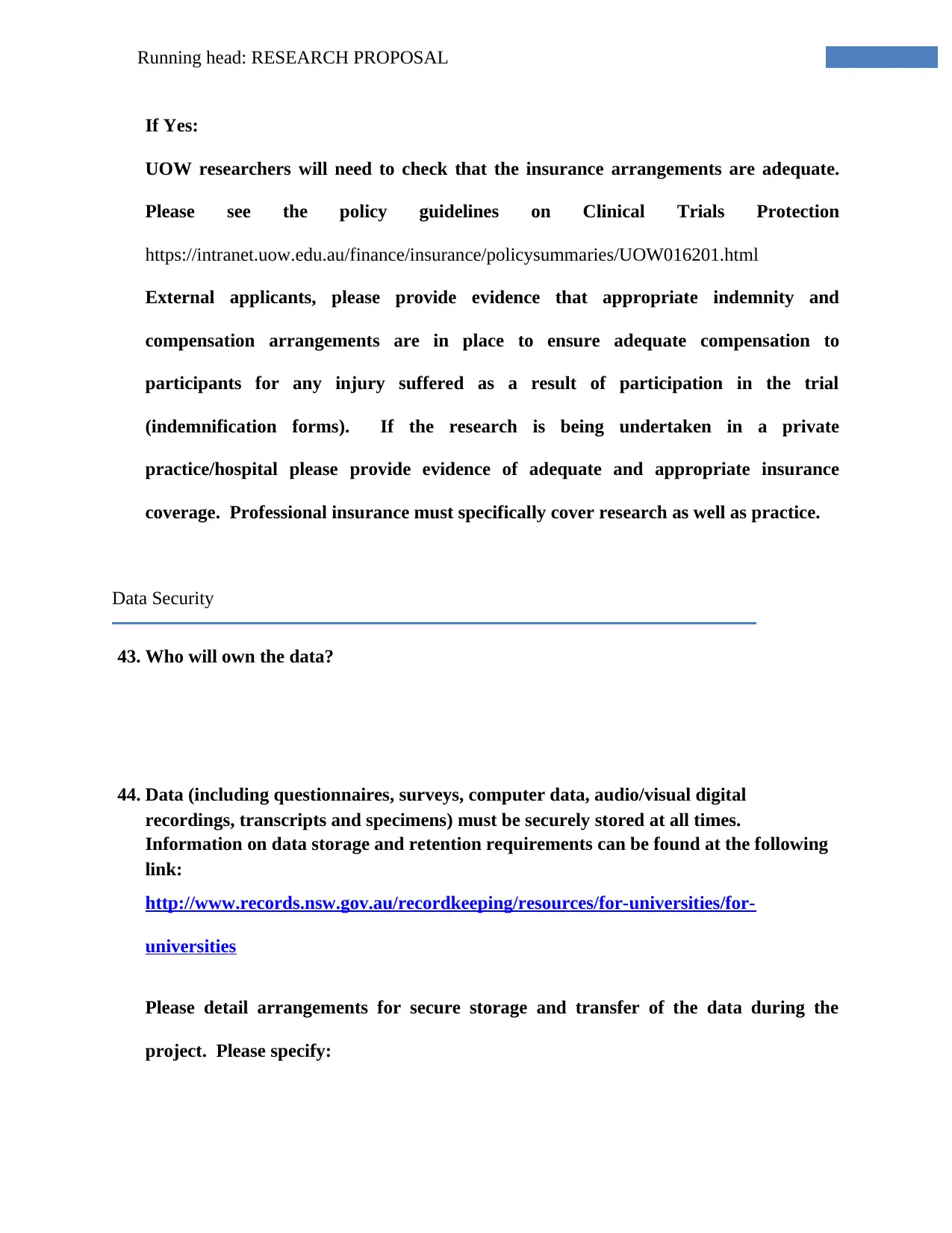
Running head: RESEARCH PROPOSAL
If Yes:
UOW researchers will need to check that the insurance arrangements are adequate.
Please see the policy guidelines on Clinical Trials Protection
https://intranet.uow.edu.au/finance/insurance/policysummaries/UOW016201.html
External applicants, please provide evidence that appropriate indemnity and
compensation arrangements are in place to ensure adequate compensation to
participants for any injury suffered as a result of participation in the trial
(indemnification forms). If the research is being undertaken in a private
practice/hospital please provide evidence of adequate and appropriate insurance
coverage. Professional insurance must specifically cover research as well as practice.
Data Security
43. Who will own the data?
44. Data (including questionnaires, surveys, computer data, audio/visual digital
recordings, transcripts and specimens) must be securely stored at all times.
Information on data storage and retention requirements can be found at the following
link:
http://www.records.nsw.gov.au/recordkeeping/resources/for-universities/for-
universities
Please detail arrangements for secure storage and transfer of the data during the
project. Please specify:
If Yes:
UOW researchers will need to check that the insurance arrangements are adequate.
Please see the policy guidelines on Clinical Trials Protection
https://intranet.uow.edu.au/finance/insurance/policysummaries/UOW016201.html
External applicants, please provide evidence that appropriate indemnity and
compensation arrangements are in place to ensure adequate compensation to
participants for any injury suffered as a result of participation in the trial
(indemnification forms). If the research is being undertaken in a private
practice/hospital please provide evidence of adequate and appropriate insurance
coverage. Professional insurance must specifically cover research as well as practice.
Data Security
43. Who will own the data?
44. Data (including questionnaires, surveys, computer data, audio/visual digital
recordings, transcripts and specimens) must be securely stored at all times.
Information on data storage and retention requirements can be found at the following
link:
http://www.records.nsw.gov.au/recordkeeping/resources/for-universities/for-
universities
Please detail arrangements for secure storage and transfer of the data during the
project. Please specify:
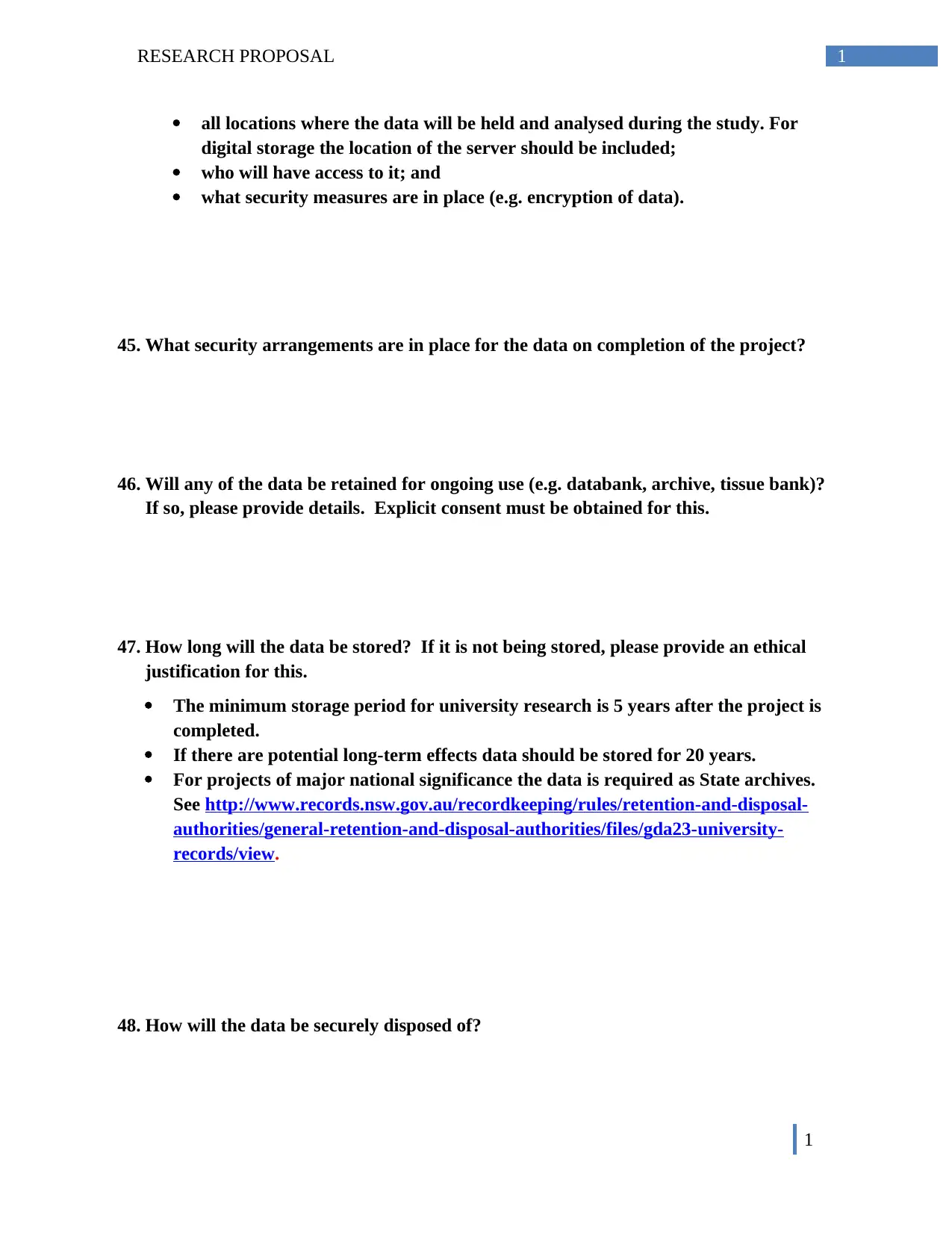
1RESEARCH PROPOSAL
all locations where the data will be held and analysed during the study. For
digital storage the location of the server should be included;
who will have access to it; and
what security measures are in place (e.g. encryption of data).
45. What security arrangements are in place for the data on completion of the project?
46. Will any of the data be retained for ongoing use (e.g. databank, archive, tissue bank)?
If so, please provide details. Explicit consent must be obtained for this.
47. How long will the data be stored? If it is not being stored, please provide an ethical
justification for this.
The minimum storage period for university research is 5 years after the project is
completed.
If there are potential long-term effects data should be stored for 20 years.
For projects of major national significance the data is required as State archives.
See http://www.records.nsw.gov.au/recordkeeping/rules/retention-and-disposal-
authorities/general-retention-and-disposal-authorities/files/gda23-university-
records/view.
48. How will the data be securely disposed of?
1
all locations where the data will be held and analysed during the study. For
digital storage the location of the server should be included;
who will have access to it; and
what security measures are in place (e.g. encryption of data).
45. What security arrangements are in place for the data on completion of the project?
46. Will any of the data be retained for ongoing use (e.g. databank, archive, tissue bank)?
If so, please provide details. Explicit consent must be obtained for this.
47. How long will the data be stored? If it is not being stored, please provide an ethical
justification for this.
The minimum storage period for university research is 5 years after the project is
completed.
If there are potential long-term effects data should be stored for 20 years.
For projects of major national significance the data is required as State archives.
See http://www.records.nsw.gov.au/recordkeeping/rules/retention-and-disposal-
authorities/general-retention-and-disposal-authorities/files/gda23-university-
records/view.
48. How will the data be securely disposed of?
1
1 out of 34
Related Documents
Your All-in-One AI-Powered Toolkit for Academic Success.
+13062052269
info@desklib.com
Available 24*7 on WhatsApp / Email
![[object Object]](/_next/static/media/star-bottom.7253800d.svg)
Unlock your academic potential
© 2024 | Zucol Services PVT LTD | All rights reserved.





